This is the website of Abulsme Noibatno Itramne (also known as Sam Minter).
Posts here are rare these days. For current stuff, follow me on Mastodon
|
There were six states where the average margin over the last five presidential elections was less than 5%. Those states were Nevada, Ohio, Florida, Colorado, Virginia and Missouri. Since the 2012 election we’ve had lots of 2016 general election match up polls in Ohio, Florida, Colorado and Virginia. But nothing in Nevada or Missouri. No polls at all.
Today I added the first Nevada results for the 2016 cycle, a recent poll from Gravis.
The only category change coming out of this was for Clinton vs Bush.
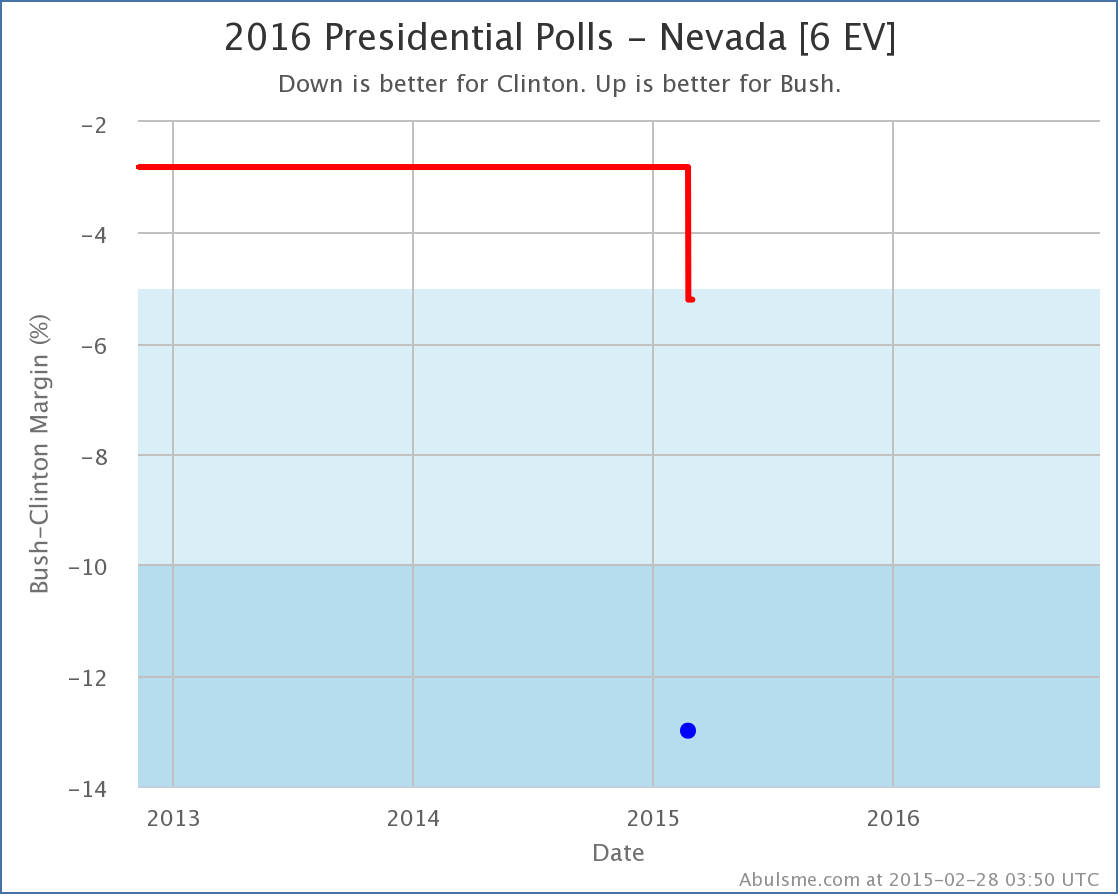
The margin over the past five elections in Nevada had ranged from the Republican by 3.5% (in 2000) to the Democrat by 12.5% (in 2008), but the average was Democrats by 2.8%, which gave Nevada an initial classification of “Weak Clinton”.
Gravis polled five different Republicans against Clinton. One of them (Sandoval) actually beat Clinton. The rest lost, and generally by a worse margin than the old average, but not by enough to push the average into a new category. Bush on the other hand did VERY badly in this poll, losing to Clinton 50% to 37%, or a 13% margin.
As the first actual head to head polling in Nevada, we’re still basing things primarily on old presidential election results, but that bad a result was able to single handedly move the the average to a 5.2% Clinton lead, and thus moved Nevada into the “Strong Clinton” category.
According to my simple model, this takes the state out of the list of possible Bush wins. At least for now… Perhaps this poll is an outlier and the next poll will make the state closer again. With one real poll, you wouldn’t want to feel too confident of what this stare really looks like quite yet.
For now though, this of course further lowers Bush’s “best case”:
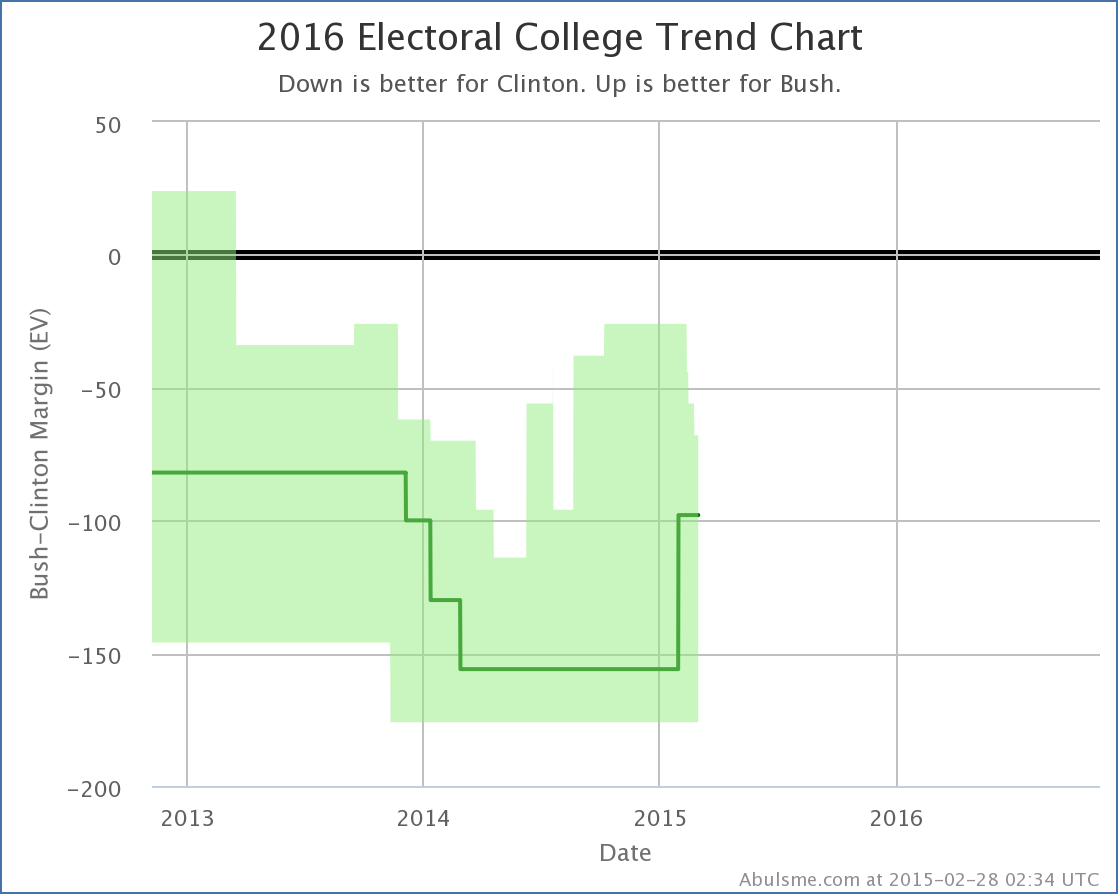
This makes the full national summary for Clinton vs Bush look like this today:
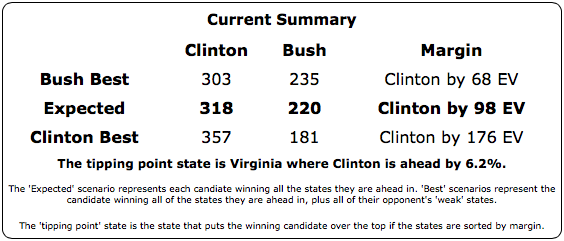
Now, this doesn’t look great for Bush, but he may start improving in Nevada (and other states) as we start getting into real campaigning. Maggie Haberman is reporting in the New York Times that the first TV ads specifically targeting Clinton will air this weekend. These of course will not be the last. It will not be surprising to see things move toward the Republicans as this process gets into full swing.
And of course we still need polls in Missouri. :-)
So… stay tuned.
Note: This post is an update based on the data on my 2016 Electoral College Analysis Site. All of the charts and graphs seen here are from that site. Graphs, charts and raw data can be found there for the race nationally and in each state for every candidate combination that has been polled at the state level. In addition, comparisons of the best polled candidate combinations both nationally and each in each state are available.
[Edit 06:06 UTC to add note at end which will become standard on these update posts.]
Another day and yet more polls moving things around. So lets go…
As usual click on any of the charts for more detail.
Clinton vs Paul
First of all, the latest batch of polls has Clinton vs Paul once again the “best polled” candidate combination, pushing Clinton vs Bush out of that spot. Keep in mind this does NOT mean they are the frontrunners in their respective parties, just that there have been more polls in the closest states than there have been for other candidate pairs. This means the default view on election2016.abulsme.com is now Clinton vs Paul. But the gap between them on my polling quality metric is very small, so don’t be surprised if they switch places again.
Next, a new poll in Virginia improved Paul’s standing slightly. No category change, Virginia is still a “Strong Clinton” state based on current polling against Paul. But the tipping point was moved:
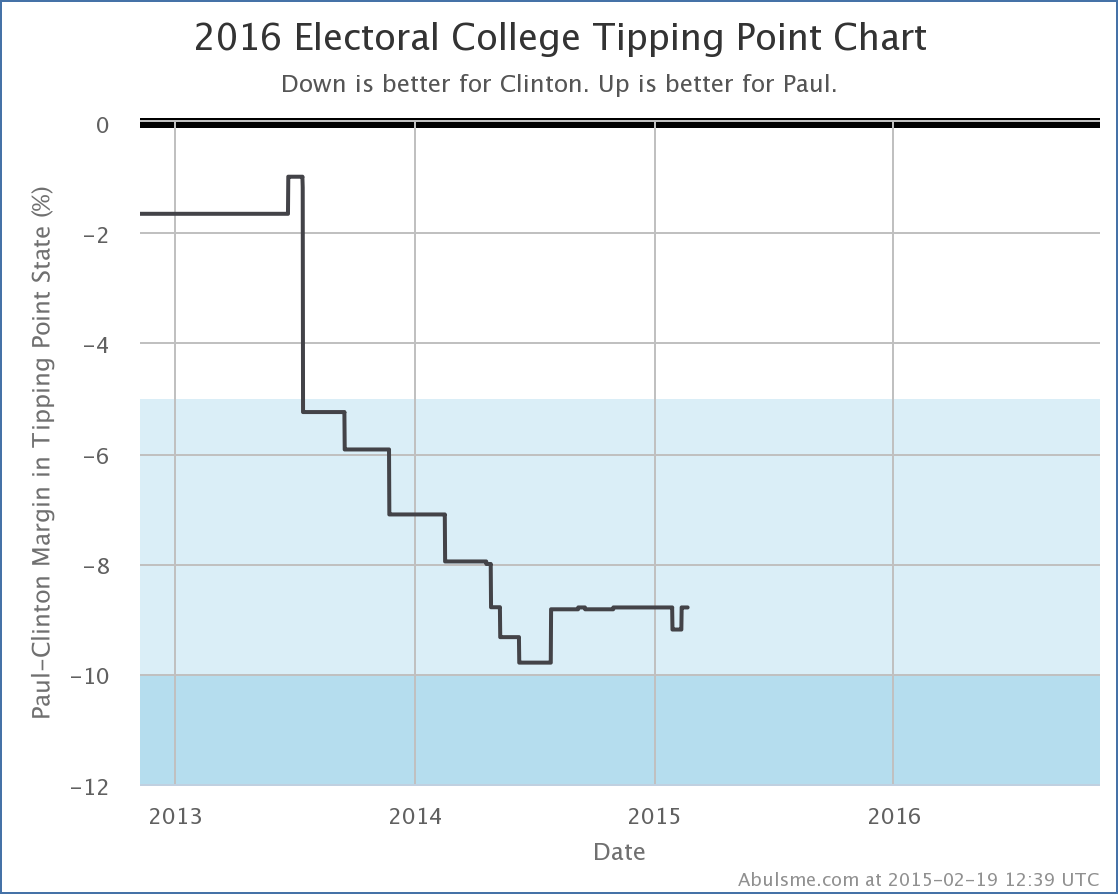
The tipping point moves from Clinton by 9.2% in Ohio, to Clinton by 8.8% in Virginia. This represents how big a uniform move in the polls across ALL states would have to happen to give Paul the edge in the Electoral college. This is basically because at the moment, to win, Paul would have to flip North Carolina (0.2% Clinton lead), Nevada (2.8% Clinton lead), Iowa (4.2% Clinton lead), New Hampshire (4.9% Clinton lead), Minnesota (7.0% Clinton lead), Michigan (8.6% Clinton lead), and Virginia (8.8% Clinton lead). [This is the list of states that are closest that would need to be flipped, there are of course other combinations that would do the trick if Paul flipped states with even bigger Clinton leads.]
Since Virginia would be the state that would put Paul over the top, it is the tipping point state and the margin there is the amount everything would have to move to make this scenario happen.
Clinton vs Bush
This combination sees relevant changes in Colorado, Iowa and Virginia.
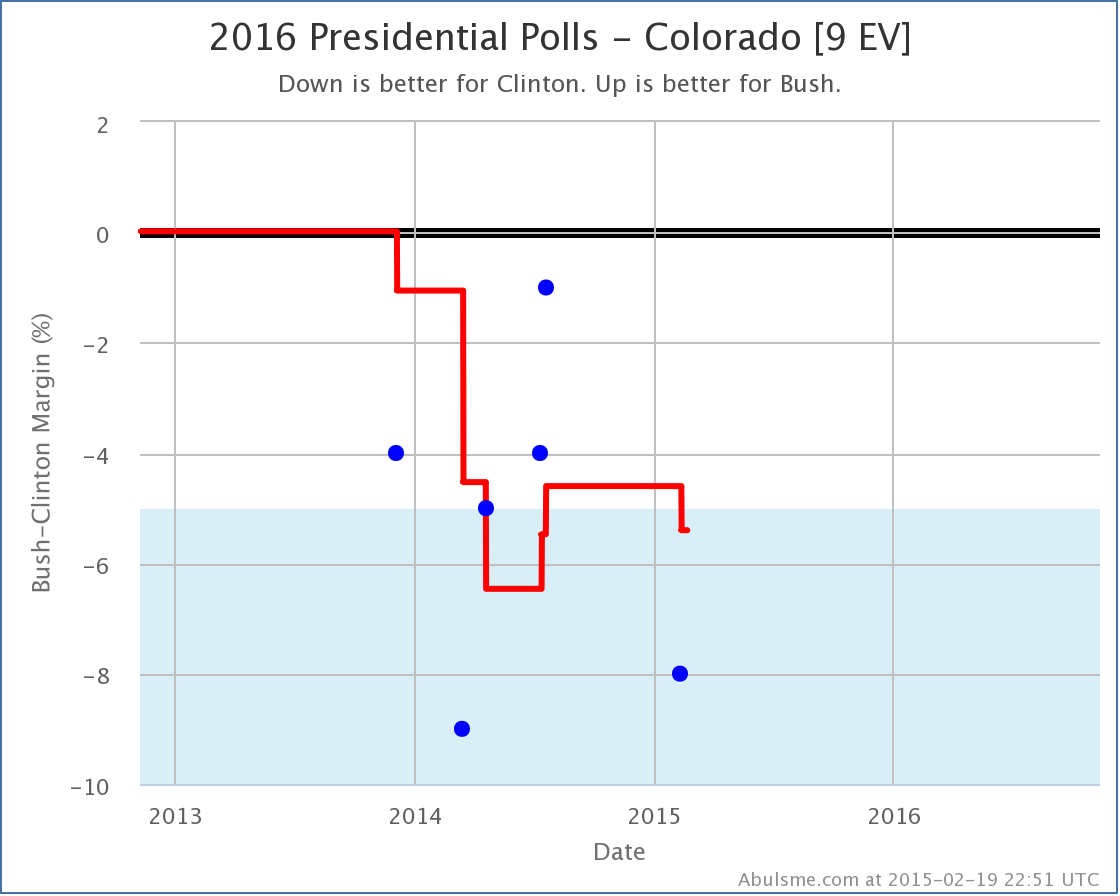
In Colorado, Clinton’s lead grows to over 5%, so this state moves out of contention and into “Strong Clinton”. (For now anyway, but do I really need to repeat just how early things are, and how relatively sparse polling still is too?)
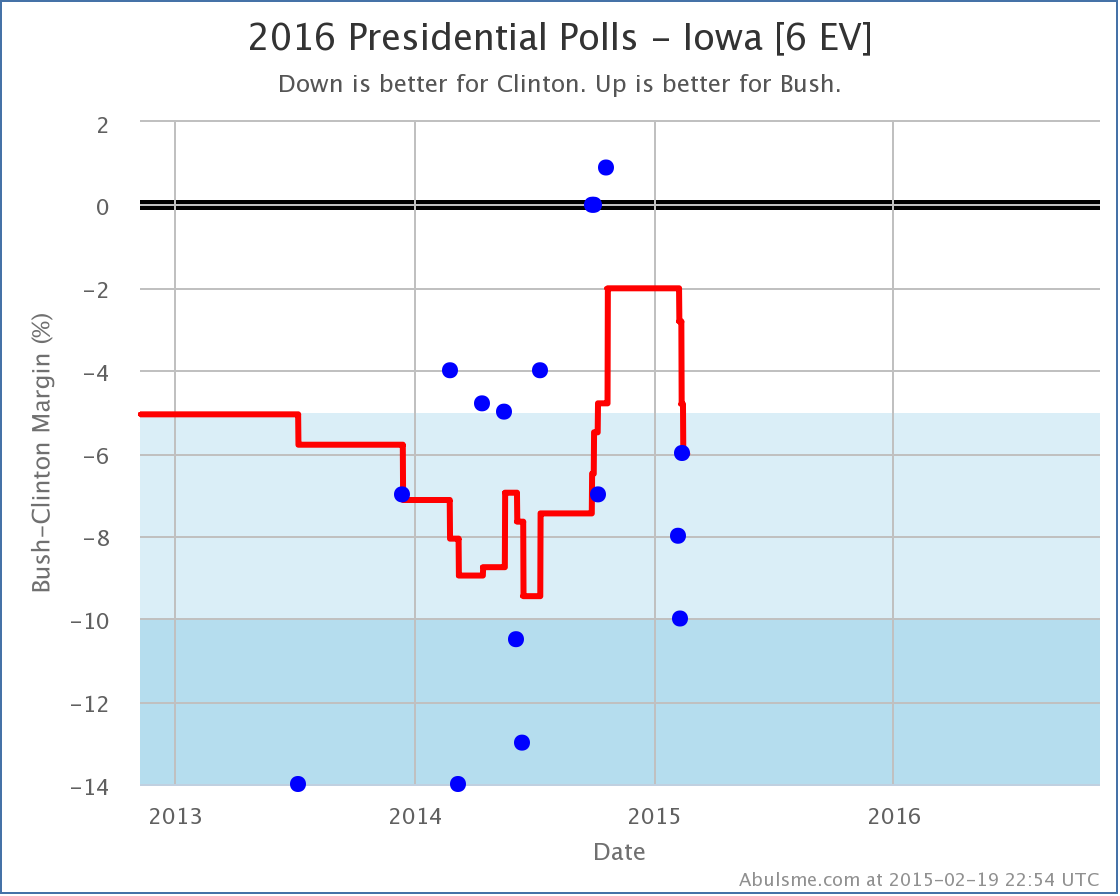
Same thing in Iowa. Although in Iowa, it looks like we might have a situation where the polling is returning to “normal” after a couple of outlier polls, while you could argue that in Colorado, the “true” state might just be bouncing around the 5% boundary line.
In either case, we shouldn’t be too surprised if the states get closer again.
With both of these states moving out of the “Weak Clinton” category, Bush’s overall best case against Clinton deteriorates a bit:
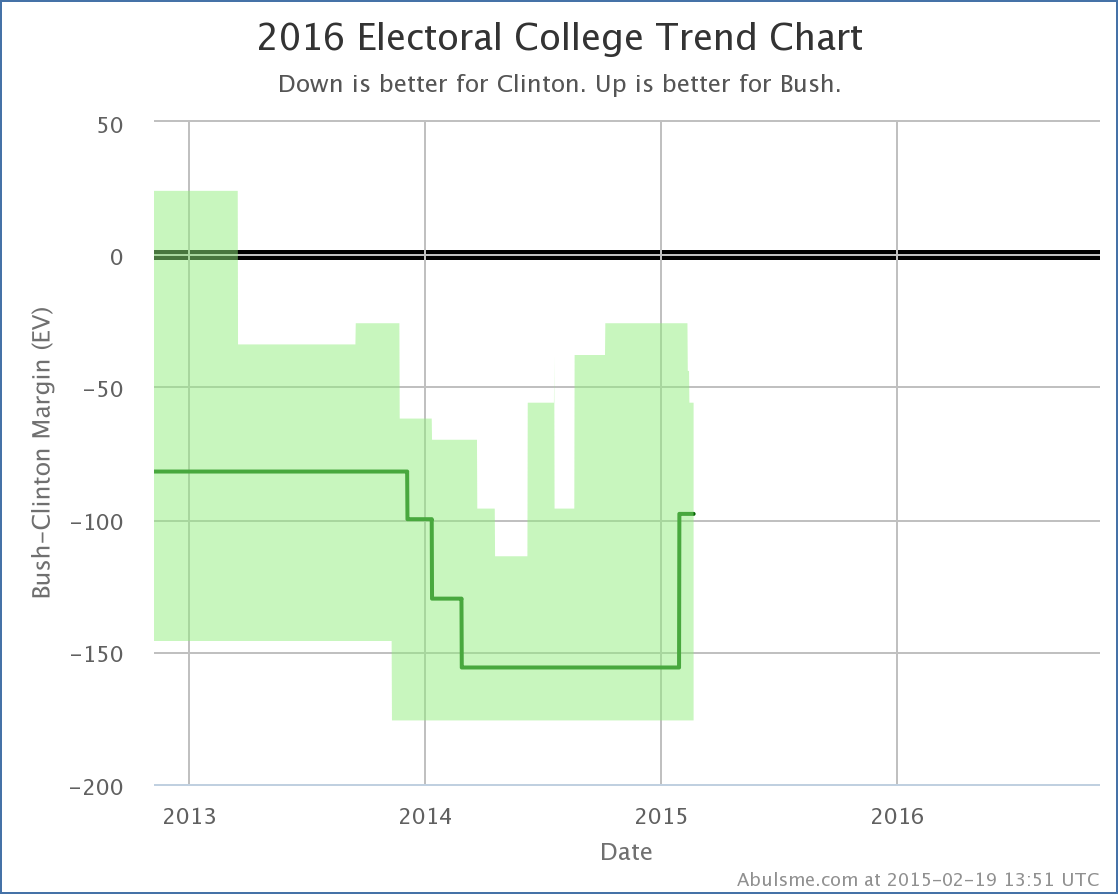
With this (plus another Iowa poll that was added yesterday) Bush’s best case against Clinton moves from losing by 26 electoral votes to losing by 56 electoral votes.
But while things haven’t been moving his way in Colorado or Iowa, in Virginia the latest polls have actually been moving toward Bush. No category changes… Virginia moved from a 7.0% Clinton lead to a 6.2% Clinton lead. This was enough to move the tipping point in Bush’s direction:
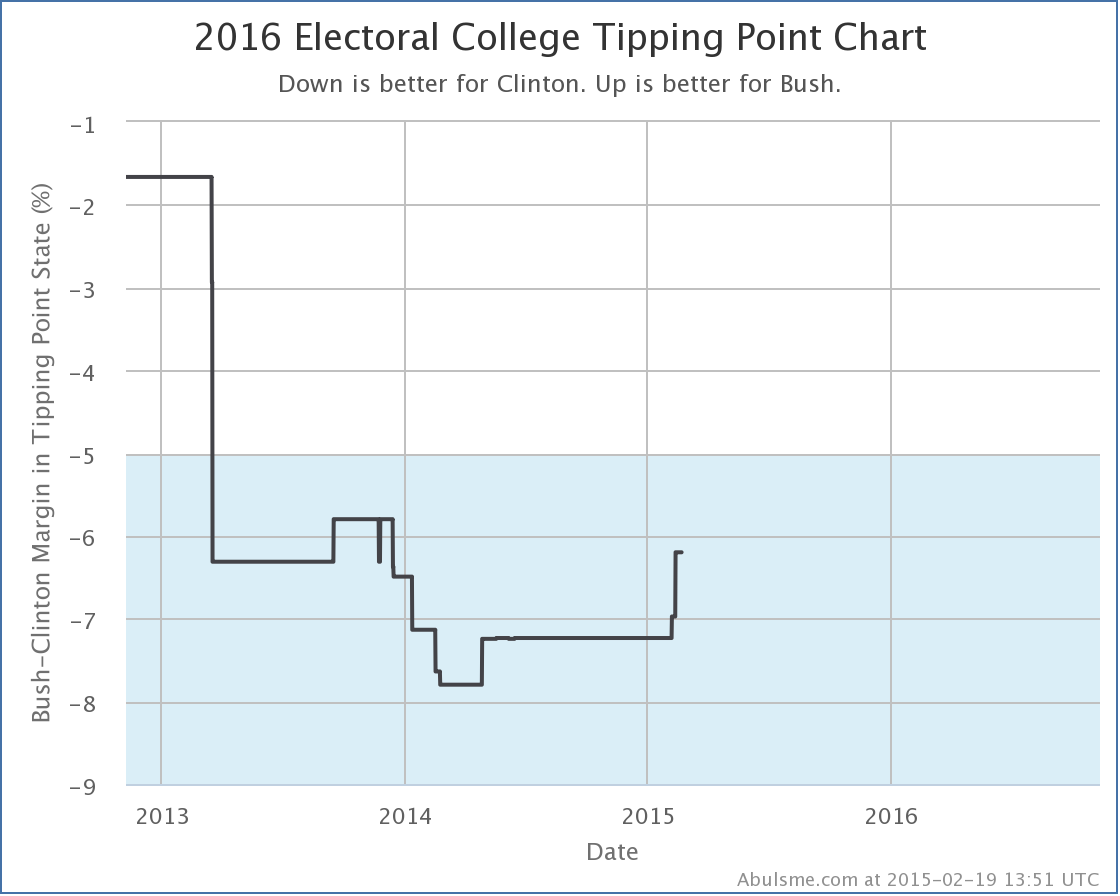
Virginia was the tipping point before this move, and it didn’t leapfrog any other states, so the tipping point stays in Virginia as it moves.
So Bush’s best case is getting worse, but his overall position is getting better? Yes, basically.
With current polling Iowa and Colorado now look like they aren’t competitive. So that is worse for Bush. But in order to win, Bush would have to flip a LOT of states, and the one he needs that he is furthest behind in is Virginia… but he is now not quite as far behind there. So if he is going to move all the states he needs to in order to win, he’s actually got a little bit less to move overall, even though Iowa and Colorado just moved a little further away.
Other folks
Just yesterday I was noting that Clinton vs Walker, despite being talked about quite a lot was still #18 on the ranking of best polled candidate combinations. With todays polls, he burst into the Top 10, debuting at #9, pushing Biden vs Rubio out of the Top 10. Still a bit away from the Top 5 combinations that I highlight here as having enough polling to say something useful about the race, but getting closer. If he continues to get lots of polling attention, while Clinton vs Ryan and Clinton vs Cruz and such do not, then he may get there sooner rather than later.
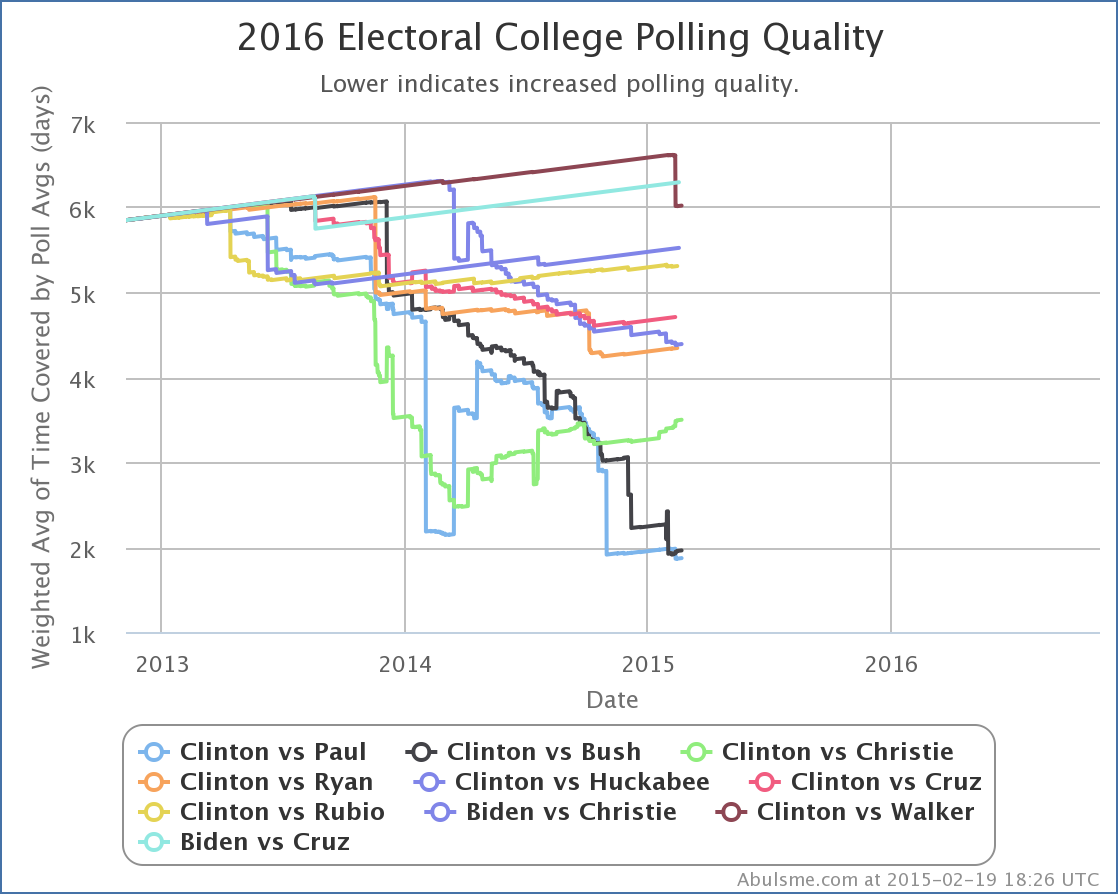
If changes keep coming in at this rate, I may need to move to a once a week update format, at least until we get a bit closer to the election. In any case, with today’s batch of new polls, we get a couple of status changes in Iowa, which in turn shift the national picture a bit.
Click on any of the charts to see more detail.
Clinton vs Paul
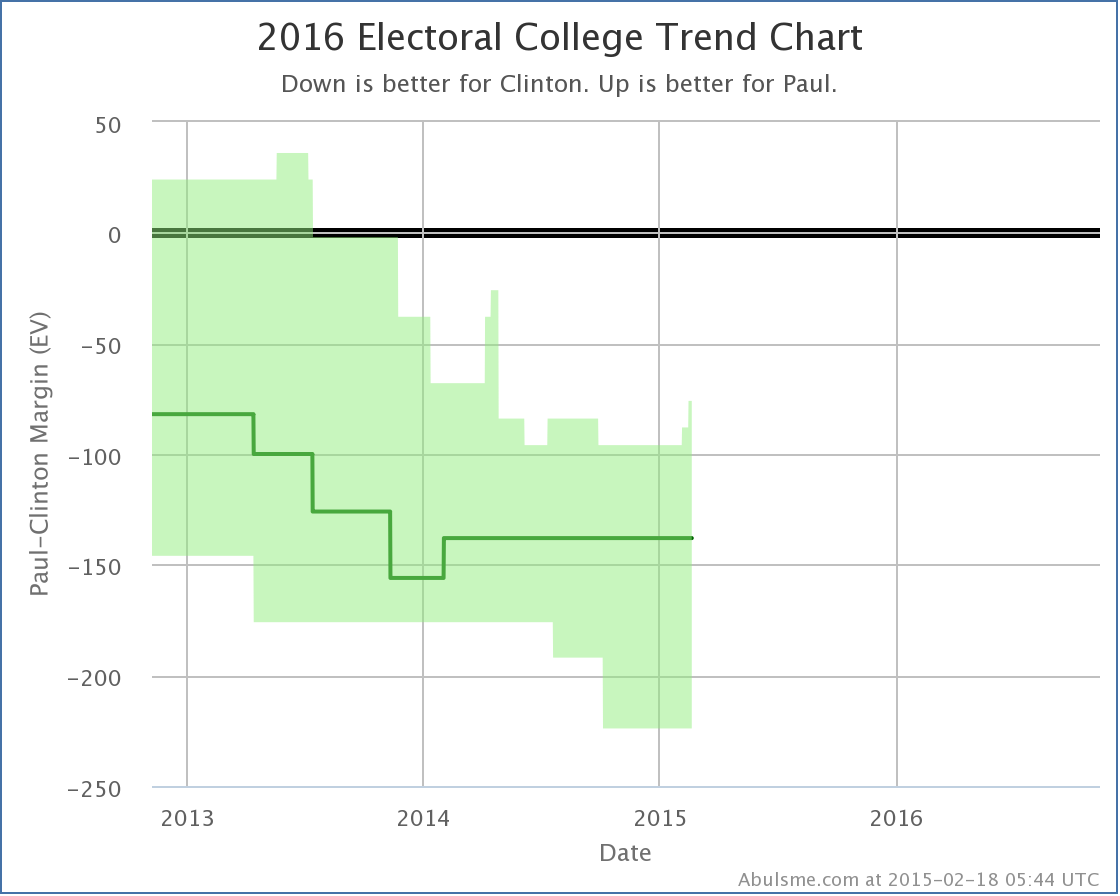
With today’s update, Iowa moves into the “Weak Clinton” zone, meaning that I consider it to be close enough to allow for the possibility of Paul winning. This improves Paul’s best case against Clinton to losing by 76 electoral votes. A couple of weeks ago, Paul’s best case was to lose by 96 electoral votes. So there does seem to be some movement here.
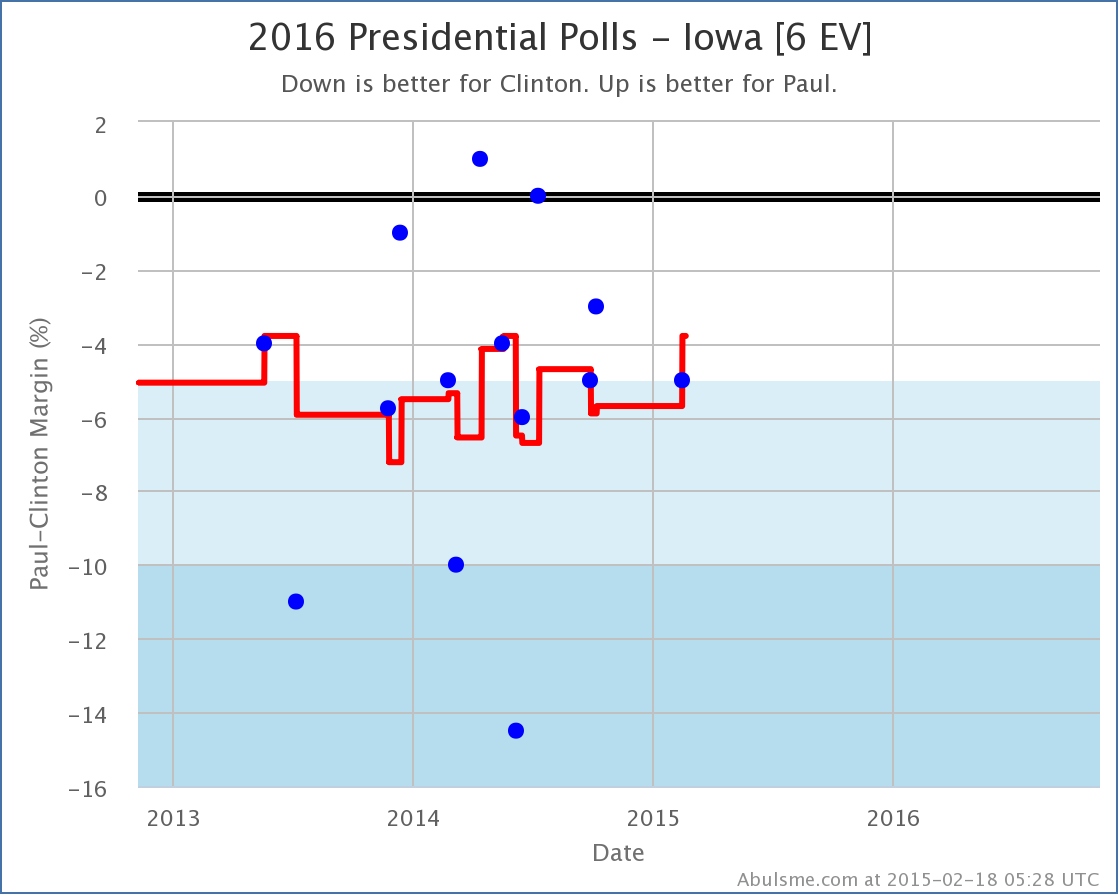
Looking at the actual polls in Iowa though, this trend is a little less clear. Iowa seems to have been bouncing back and forth over the 5% Clinton lead line for the last two years, spending more time with Clinton further ahead than 5%, but with occasional temporary movement toward Paul. Can we say that this time is a real “trend” rather than just another short term bump? Nope. Or maybe the average being further in Clinton’s direction is really just the result of a handful of outlier polls and really this “should” have been closer all along. Maybe. We’ll have to wait for more polls to see.
For now though, my charts show movement toward Paul.
Clinton vs Huckabee
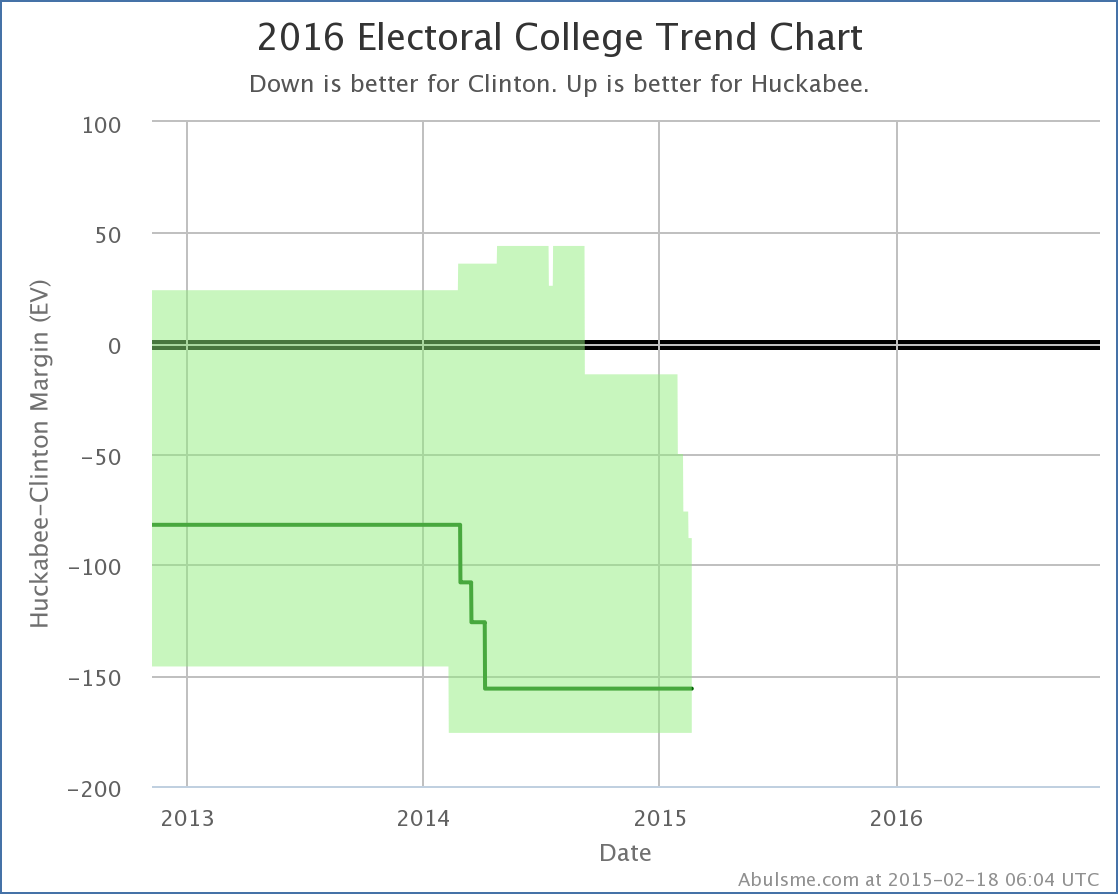
While Paul’s picture is improving, Huckabee’s continues to decline. In the latest update, Iowa slips out of Huckabee’s best case. Huckabee’s best case is now to lose to Clinton by 88 electoral votes. A month ago, his best case was losing by only 14 electoral votes, but states keep slipping away. Now, there has been a lot less Clinton vs Huckabee polling than there has been Clinton vs Paul polling, so there is a good chance a lot of this has simply been getting enough polling to get a good picture, rather than actual movement.
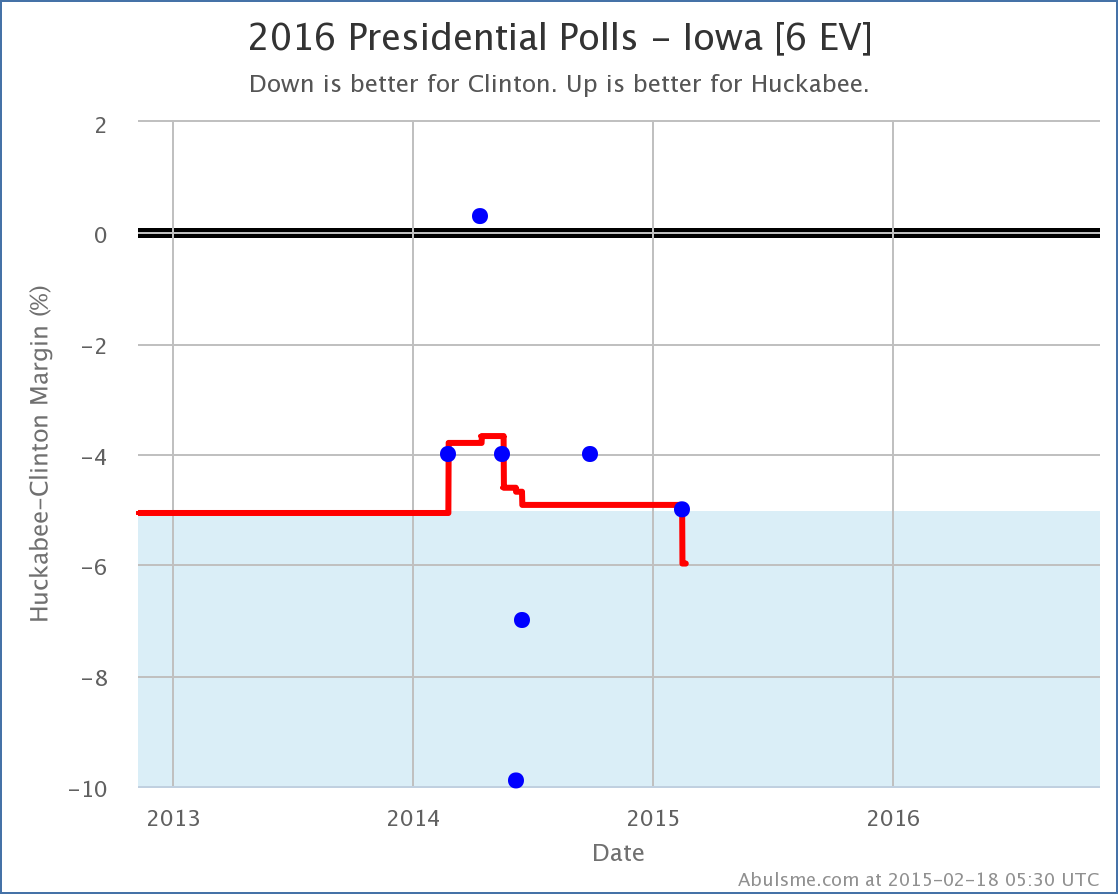
Specifically looking at the individual Iowa polls, you can see that we already did have five polls in Iowa, so the picture wasn’t dependent on previous election results, but there have only been 7 polls compared to the 14 for Clinton vs Paul. And there is quite a scatter between those polls (as there also was with Clinton vs Paul). The “movement” here is basically one extreme poll (the one showing Huckabee actually ahead in Iowa) falling out of the average, while another extreme point (the one showing Clinton ahead by 10%) remains in the average.
As with the Paul situation, it is far from clear that this is a real trend as opposed to just a temporary bump in this direction, and the next polls could change the picture again. It is well within the realm of possibility that the “real situation” for both of these candidates is that Clinton is just about 5% ahead of them, and they will just bounce back and forth between my categories as new polls come in.
Comparison
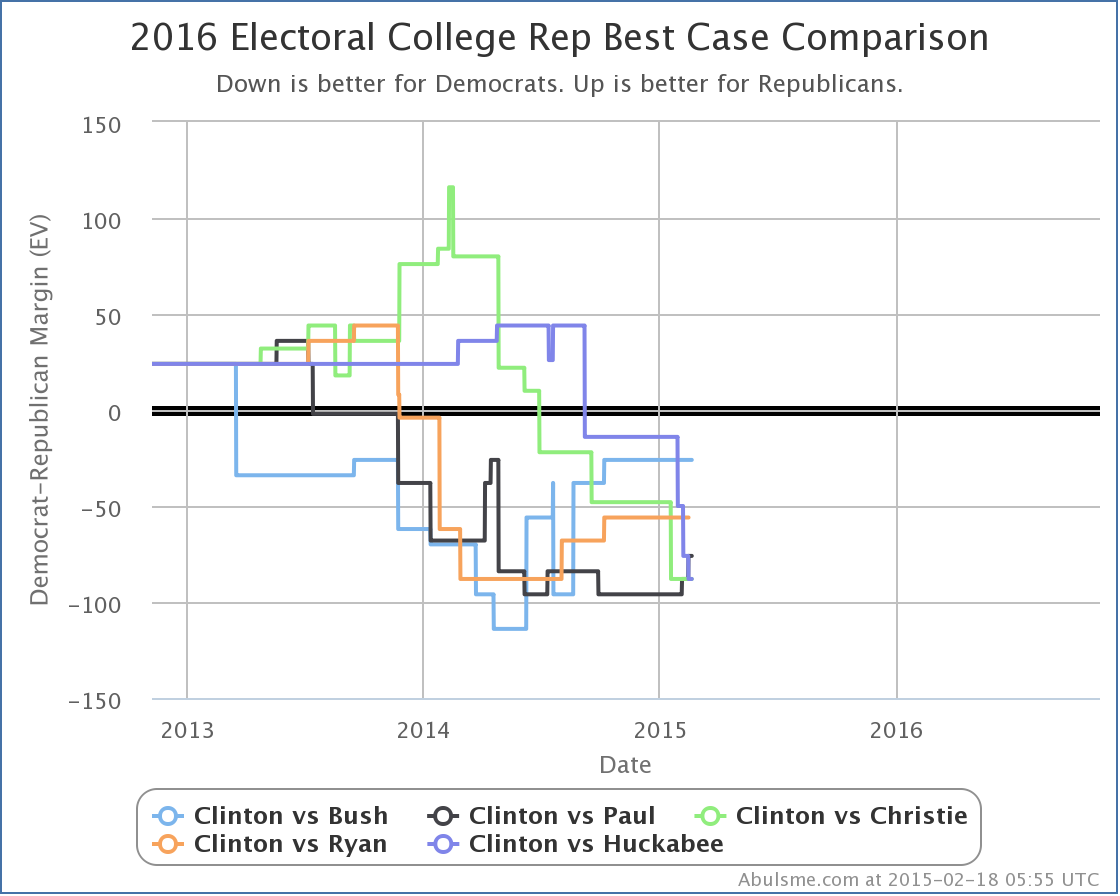
Since in both cases today, what has changed is the Republican best case, lets look at the trends there with the five best polled candidate combinations. Looking just since the 2014 elections, the movement on this specific metric has been Paul improving, Bush and Ryan flat, Christie and Huckabee declining. Other metrics show slightly different trends, but when all of the Republicans here are losing even when you give them all the close states, the first step is just to start making states close, and this chart measures that process.
But wait, Ryan has said he isn’t running, and what about this Walker guy? A bunch of people have been talking about him lately. Well, I recently introduced this new chart on where the candidate combinations stand in my “polling quality” metric:
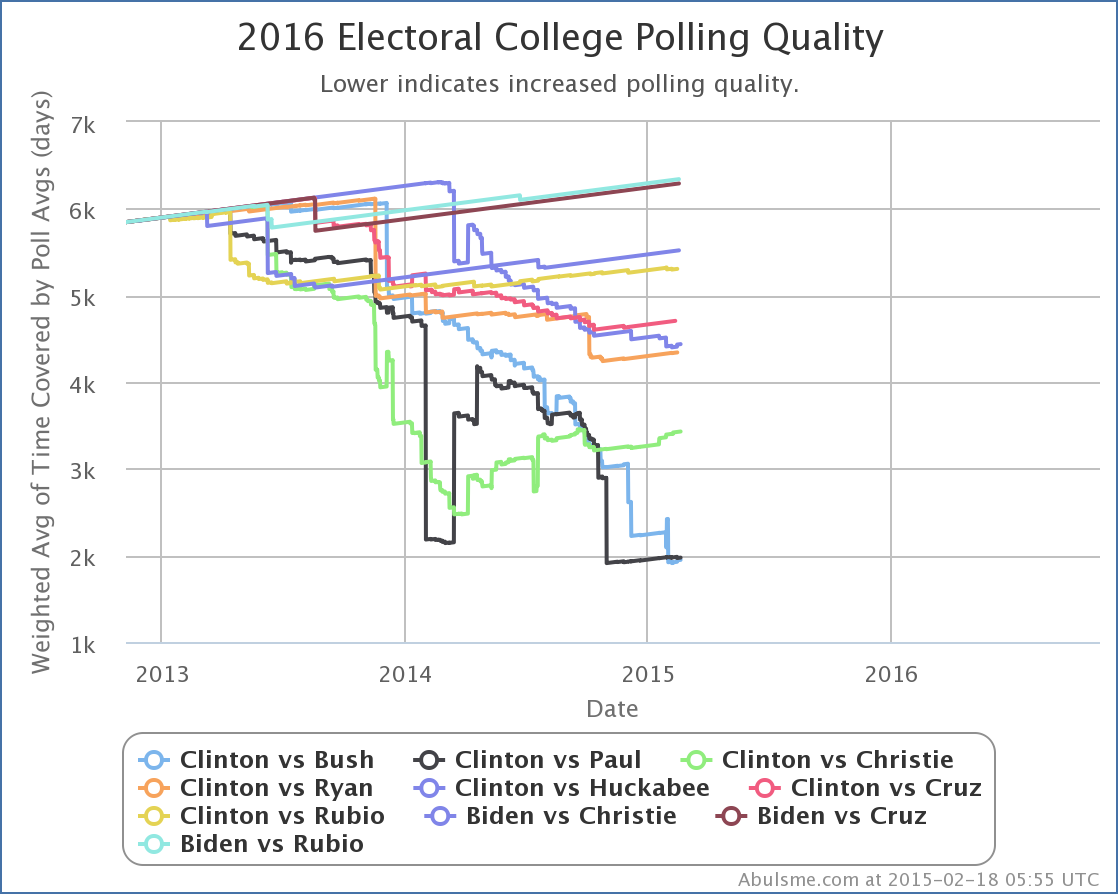
This shows the best TEN polled candidate combinations, not just the top five, so we can see if new candidate pairs are heading toward the top five.
On this chart the lower the line, the better the polling quality. Poling quality is measured by the average amount of time used in the polling averages across the 56 jurisdictions that have electoral votes, weighted such that close states count a lot more than states where one candidates lead is large. A new poll may or may not improve polling quality, since if new poll makes a state less competitive than it was, the weight of that state also decreases in this metric. If there are no new polls for a candidate pair, the polling quality slowly gets worse as each day passes.
Anyway, what do we see here? Well, if trends continue, looks like Clinton vs Huckabee may soon pass Clinton vs Ryan, and Clinton vs Bush and Paul are very close to each other so easily could flip back and forth, but Clinton vs Cruz hasn’t shown any signs lately of much life. Nor any of the others in the 6-10 zone. So we may not get any new combinations in the top five for a little while yet.
How about Clinton vs Walker? Oh, yeah. that combination is still way out at #18 on this ranking. He stands at about 6616 on this metric, compared to 6340 for the worst of the top ten shown in the chart above and 4437 for the worst of the top five. We need a lot more state level polls of that combination before we have enough polls to meaningfully compare that scenario to the five we’re showing in the analysis here.
We are 634.6 days from the first polls closing as I write this message. But yet here I am with the fourth of these updates in a two week period. I honestly didn’t expect the polling to be picking up quite this fast. But it seems to be. So be it.
Please keep in mind that everything here describes where things are now, and how things are trending NOW. We are far enough from the 2016 election that nothing here represents a prediction for what will happen in 2016. But knowing how things look now and observing the trends still provides interesting insight.
Today I added new polls from CNU in Virgina and from Bloomberg / Saint Anselm / Purple in New Hampshire. These resulted in changes worth noting* for three candidate pairs. I’ll review them quickly in order of the magnitude of the change.
Click on any of the charts to go to the election2016.abulsme.com site for more detail.
Clinton vs Huckabee
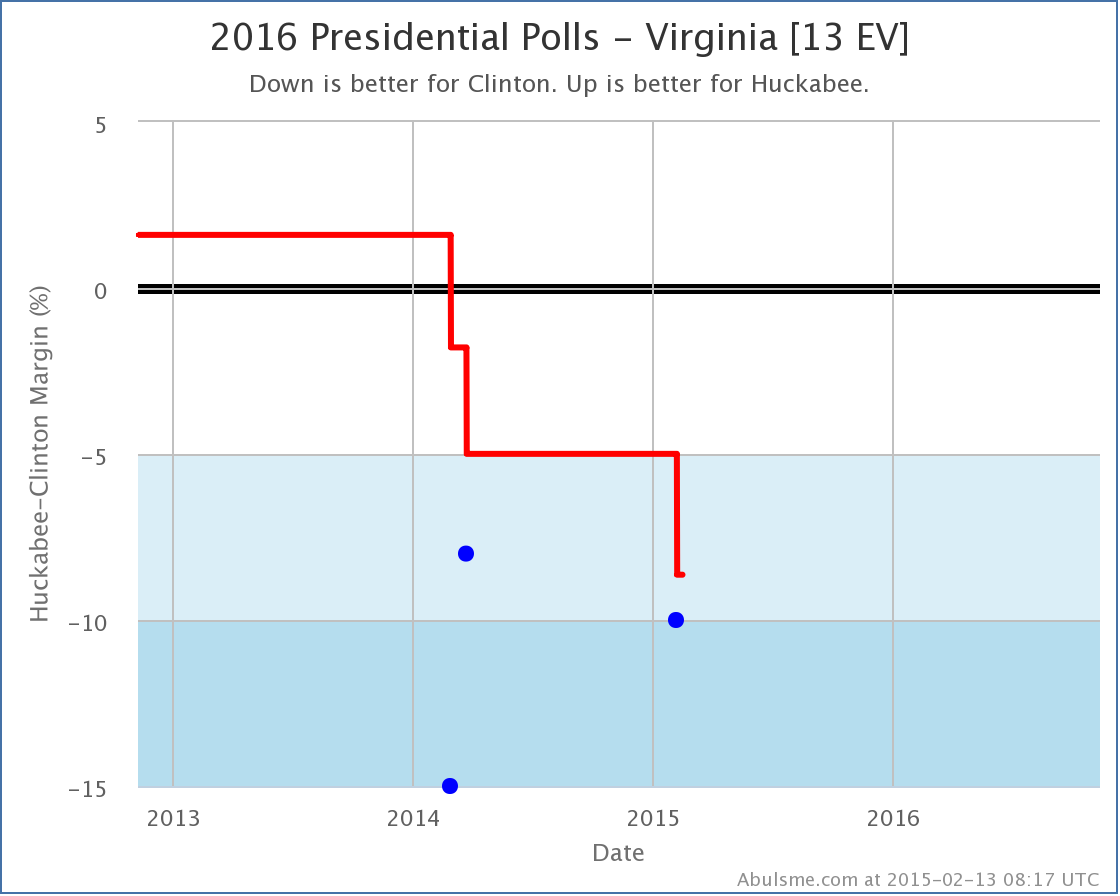
Huckabee had only been hanging on to the “Weak Clinton” category in Virginia by virtue of the fact that I pad my poll average with previous general election results if there are not yet five actual polls between the candidates in question. With the third poll directly pitting Clinton vs Huckabee in Virginia, Huckabee falls much further behind, and Virginia now seems to slip out of reach. Huckabee’s best case vs Clinton therefore gets worse.
Without Virginia in the mix, Huckabee’s “best case” (where he wins all the states he is ahead in, plus all of the states where Clinton is ahead by less than 5%) is now to lose to Clinton by 76 electoral votes.
This change also drops the “tipping point” (which represents how much of a uniform shift in polling across all states would be needed to flip the election) further in Clinton’s direction. The tipping point state for Clinton vs Huckabee is now Minnesota, where Clinton is ahead by 6.8%.
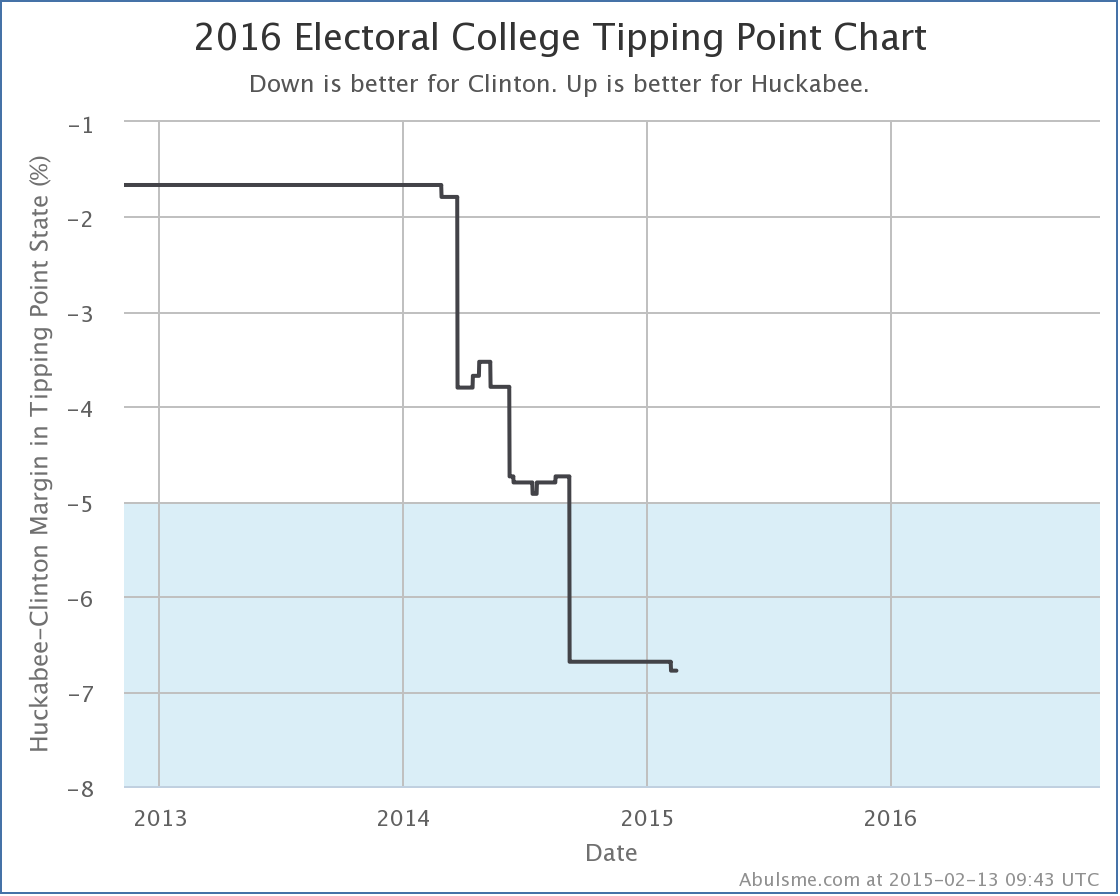
Clinton vs Paul
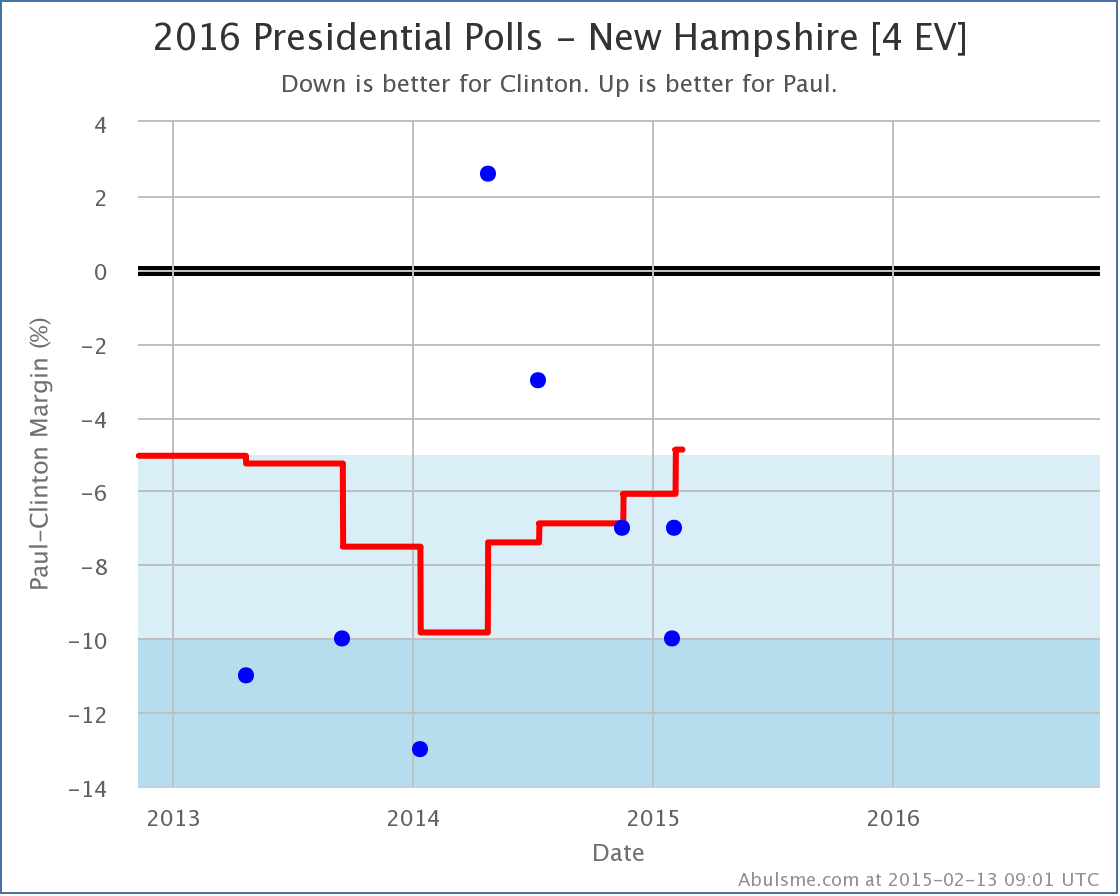
This chart of Clinton vs Paul polls in New Hampshire is interesting, and actually shows one of the disadvantages of using an average of the most recent polls, rather than some more sophisticated sort of trend smoothing. Paul’s average vs Clinton has been steadily improving for the last year. But if you look at the individual polls, you see that this is because some really bad polls for Paul from 2013 and early 2014 were “aging off” the average, being replaced by some relatively good polls for him from the last year, including one where he was actually ahead!
But if you actually look at the trend of the individual polls since then, the trend has been back toward Clinton. With a straight up poll average, this trend in the last five polls is invisible. We just know that the average of the newest five is higher than that of the five most recent polls not counting the brand new one. Basically, a poll where Paul was behind by 13% was replaced by a poll where Paul was only behind by 7%, so the average moved toward Paul… even though there may be a different trend if you look within the five polls actually used in the average.
If the trend in the last five polls is real (it may or may not be) then it would not be surprising to see New Hampshire fall back into “Strong Clinton” territory with the next poll.
For now though, we grant Paul the possibility of winning New Hampshire in his “best case” which is now to lose to Clinton by only 88 electoral votes.
Clinton vs Bush
No changes in best, worst or expected case for Bush against Clinton, but since the tipping point in this case was Virginia, and we had polling in Virginia, it is not unsurprising that the tipping point here moved, if only a little.
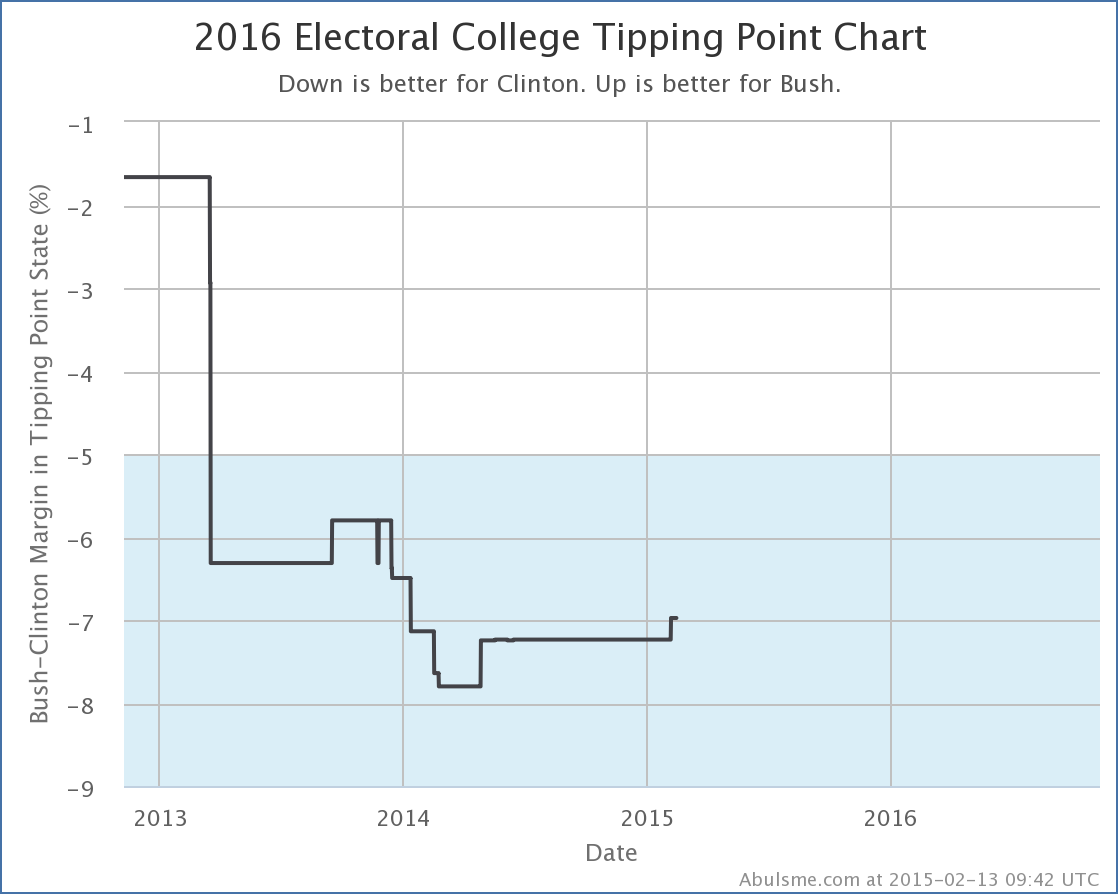
The tipping point here remains Virginia, but Bush moves from being behind 7.2% there, to only being behind by 7.0%.
And that is it for today’s update. Please explore election2016.abulsme.com to find more detail and interesting bits and pieces.
* For now, “Changes worth noting” are when the best, worst, or expected cases for one of the five best polled candidate pairs changes, when the tipping point changes by at least 0.1% for one of those candidate pairs, or if a new candidate pair becomes “best polled” or replaces one of the current five pairs on the list.
On Thursday I mentioned that if the current trend continued, new polls would push Bush into the lead in Florida and North Carolina before long. Well, only a couple days later, we have yet to see it in North Carolina, but we have that new poll in Florida.
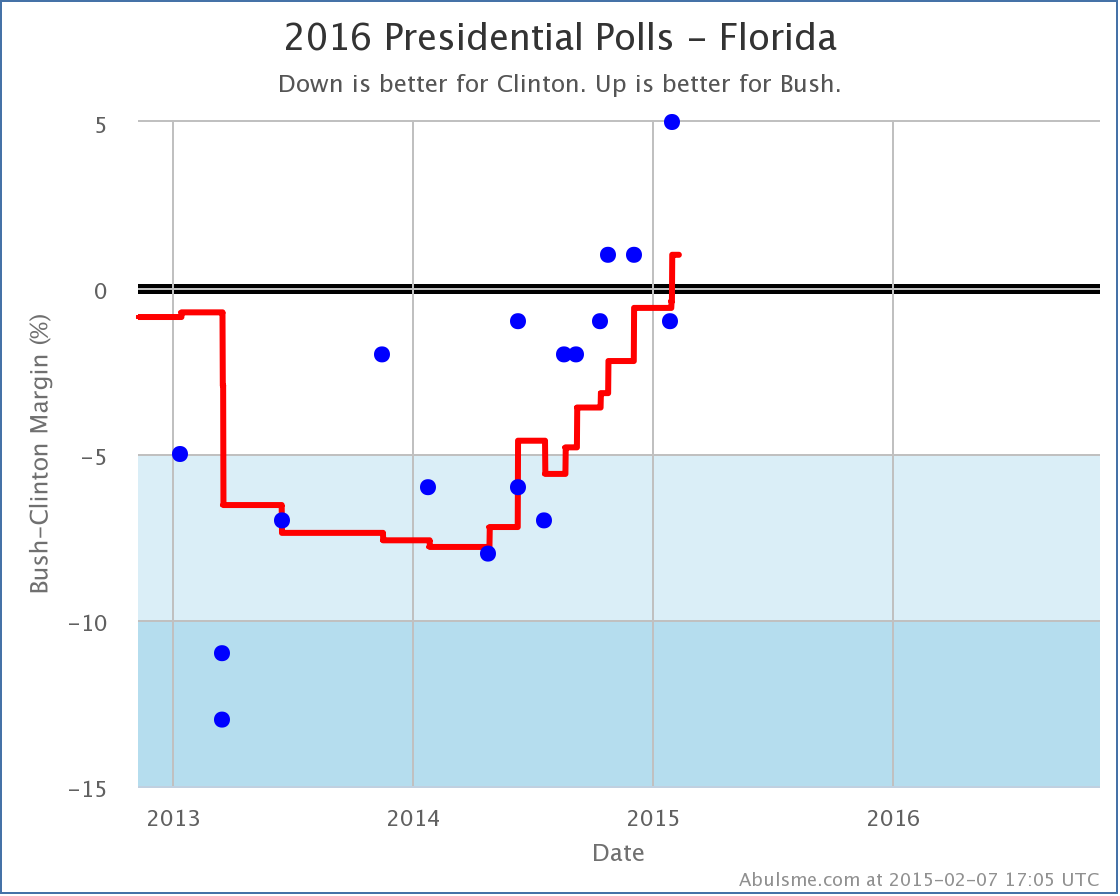
Florida is big (29 EV), so this of course makes a big difference on the national trend chart:
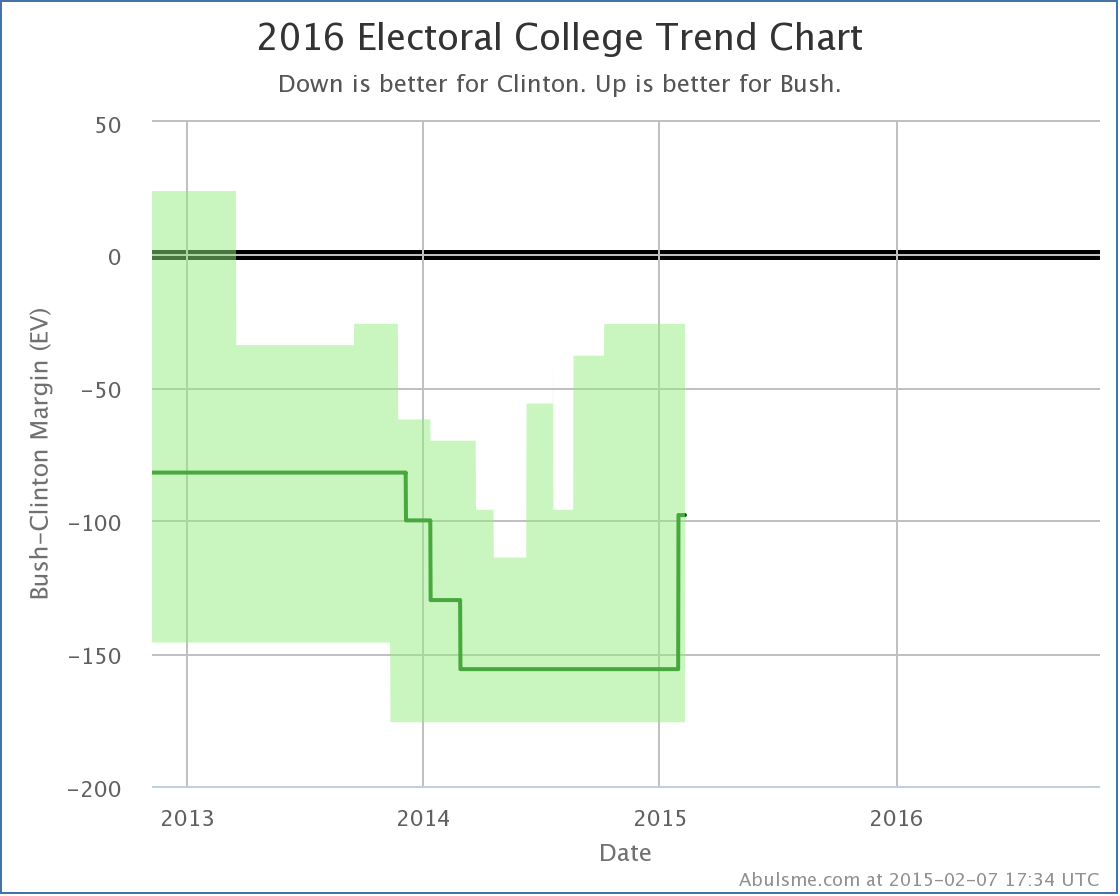
Will more states start flipping in Bush’s direction? Keep your eyes out over the next few months, the campaign is slowly getting into gear!
In the meantime, Clinton vs Bush looks like this:
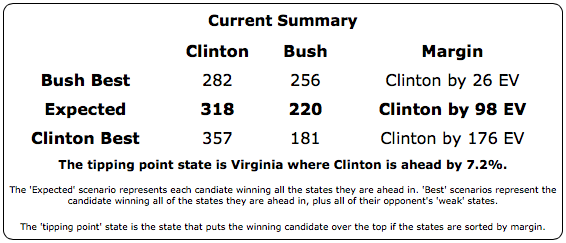
And we have just a tint of red down in Florida…
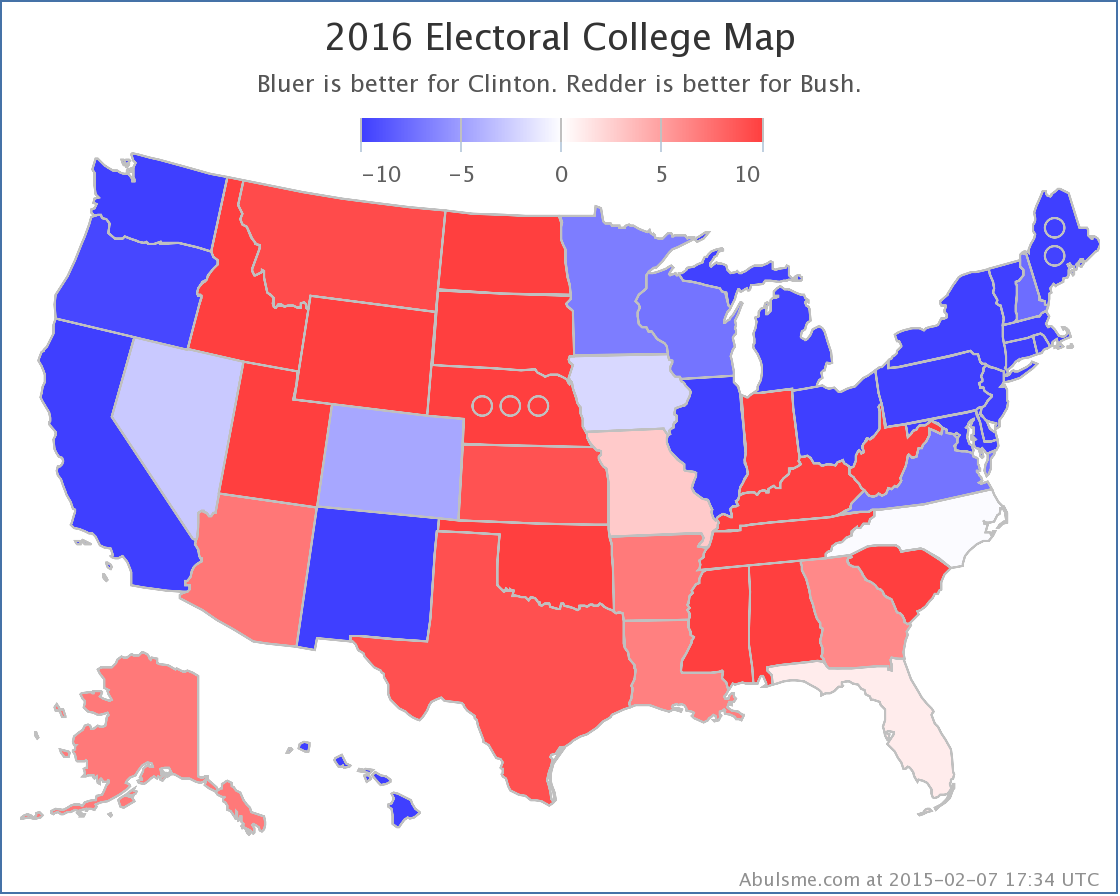
(Three electoral college posts from me in one week! Hopefully this isn’t the new normal quite yet…)
Some new polling was added today from PPP in North Carolina. It didn’t change the status of any state for any of the top five “best polled” candidates, nor did it change the tipping points for any of those. However, it did move Clinton vs Bush ahead of Clinton vs Paul in the metric I use to measure how good the polling is for the various candidate combinations. This means that Clinton vs Bush is now the default view when you go to election2016.abulsme.com.
Now, this does NOT necessarily mean that Clinton and Bush are the front runners in their respective primary races… although there is a strong argument that they are… it just means that there is currently better state by state polling data for this particular combination than any of the others.
Given this, I thought a quick overview of the Clinton vs Bush combination was in order.
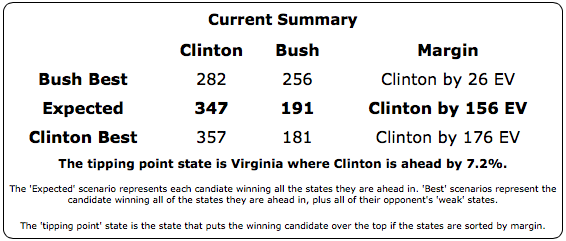
So, as with all the other “top five” Republicans against Clinton, Bush is behind, even in the “Best Case” where you give him all of Clinton’s weak states.
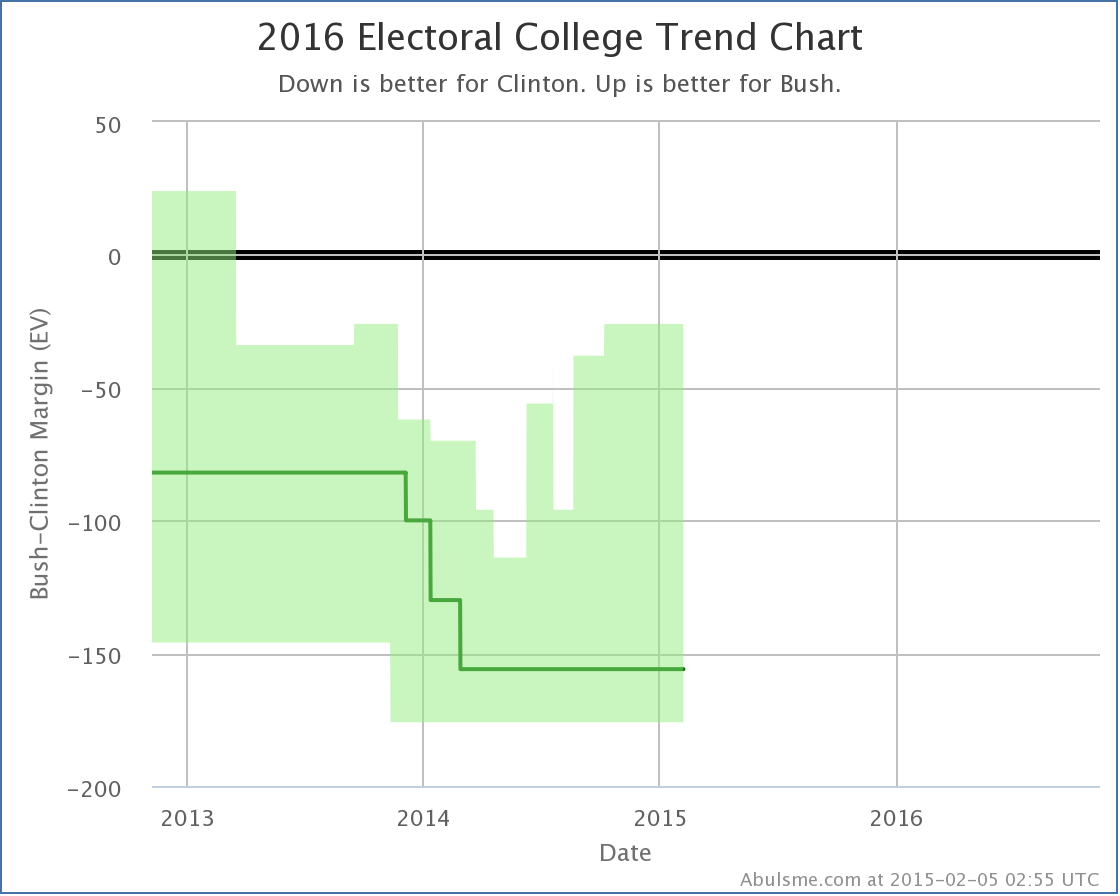
But, unlike some of the others, Bush’s “best case” has been steadily improving since last spring.
And while it hasn’t happened yet, there are two states right on the verge of flipping and improving his expected case as well…
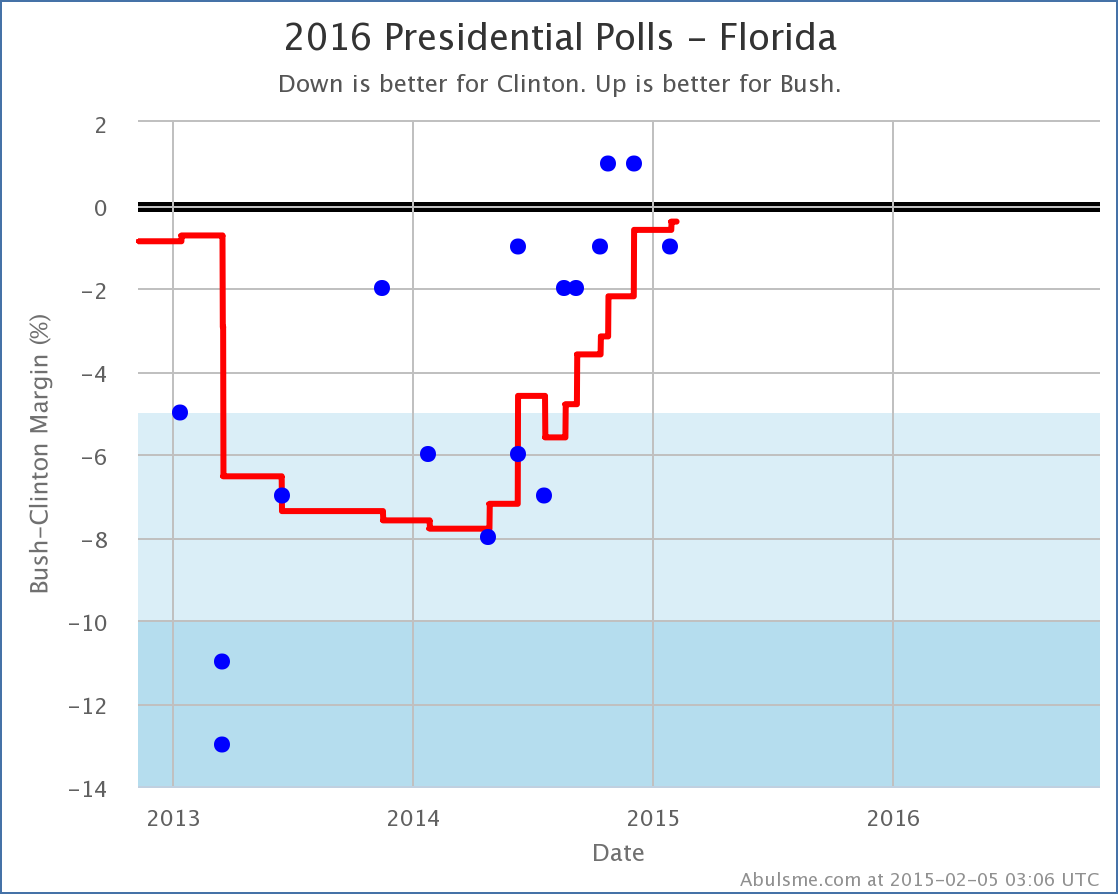
Florida, with 29 electoral votes, considered by many a “must win” for any Republican path to victory, has been trending strongly away from Clinton and toward Bush since bottoming out in the first part of 2014. Currently Clinton’s lead is 0.4% in my average. One more good poll for Bush, and Florida will move into his column.
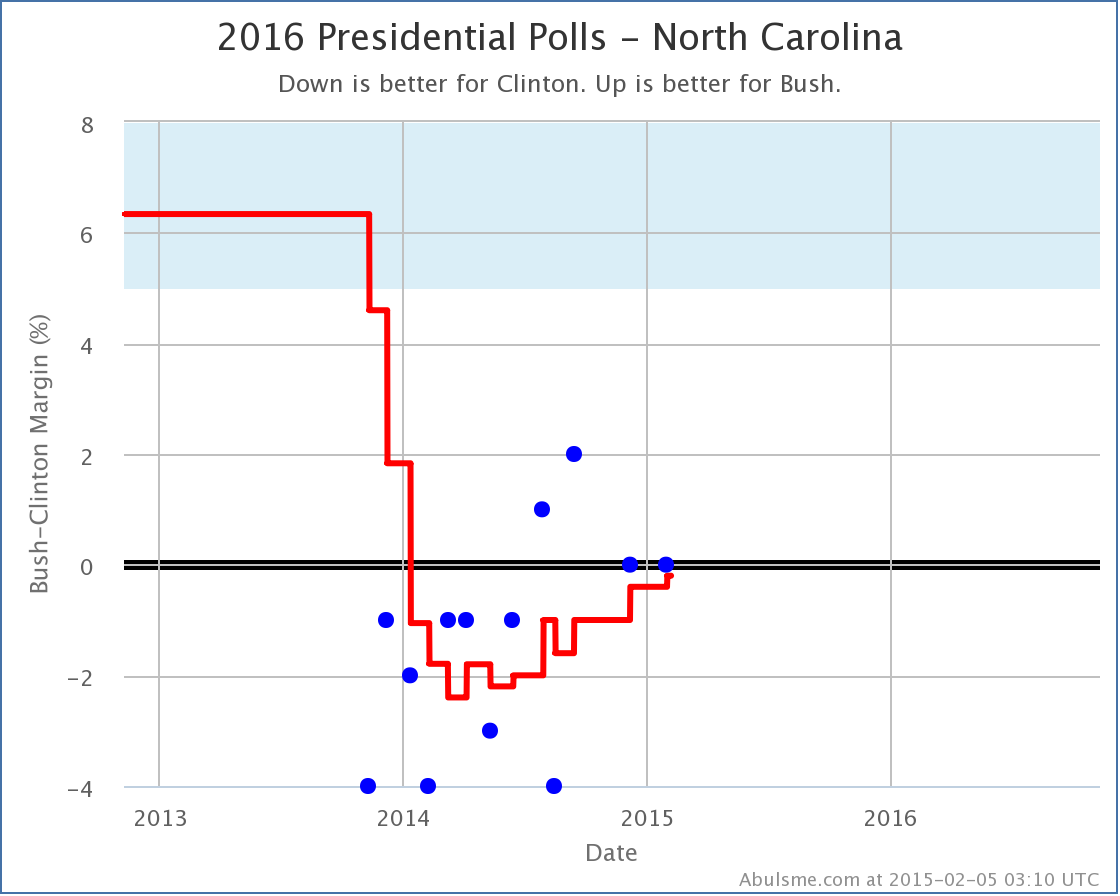
Ditto with North Carolina with 15 electoral votes, where Clinton’s lead is a minuscule 0.2%. Both these states are really neck and neck, but the trend has been in Bush’s direction in both.
Do not be surprised if these flip and Bush’s “expected case” starts moving in his direction soon.
Of course, to actually win, a lot of states need to move. The “tipping point” measures this.
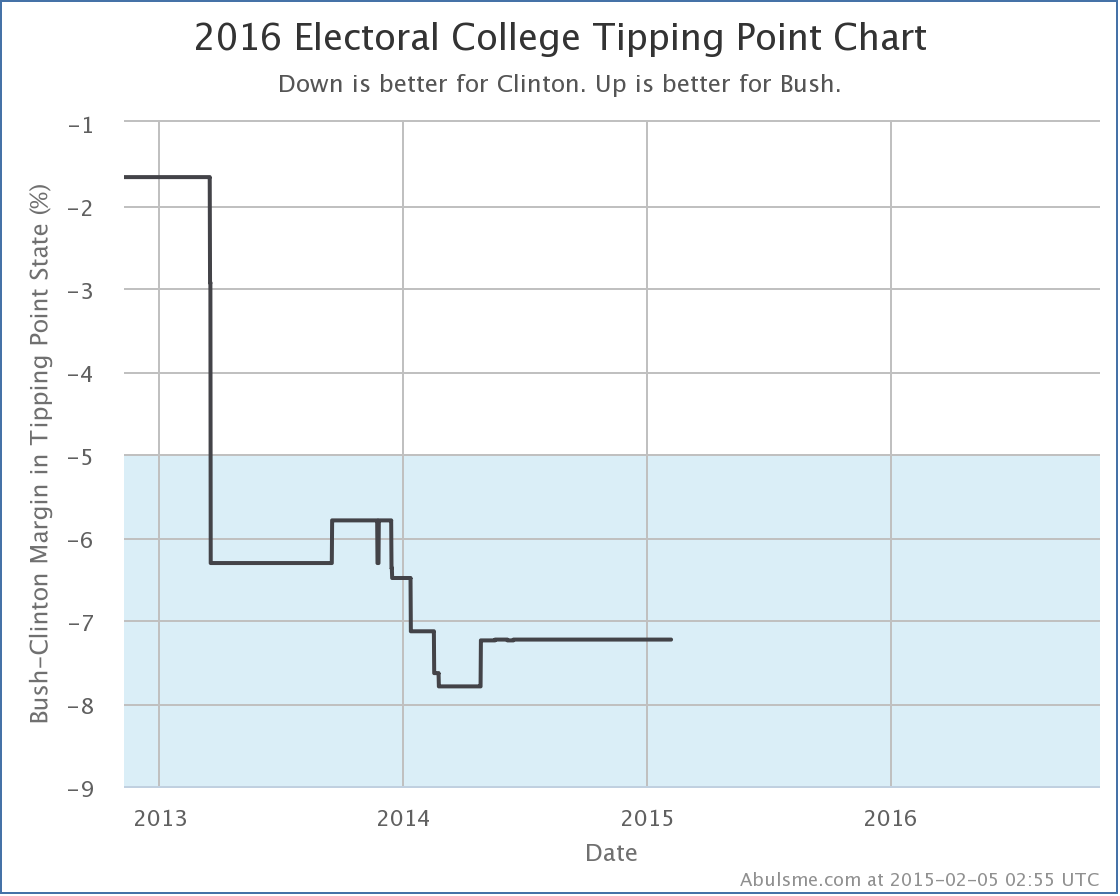
No significant movement here recently. Does this move Bush isn’t moving all the states he needs to? Maybe. But more likely, there just hasn’t been much new polling in the states near Bush’s current tipping point.
To start seeing movement in the tipping point for Clinton vs Bush, we need some new polls in states like New Hampshire (last poll in November), Wisconsin (last poll in April), Virginia (last poll in March), Minnesota (last poll in June) or Colorado (last poll in July).
The age of the polls in these states shows just how far away we still are from having a large enough volume of state level polling to have a good “real time responsive” sort of take on the situation. At this stage, polling is still slow and sparse in most states, and you have to interpret things accordingly.
Now, you can’t give a summary without the traditional map. So here is the current Clinton vs Bush map…
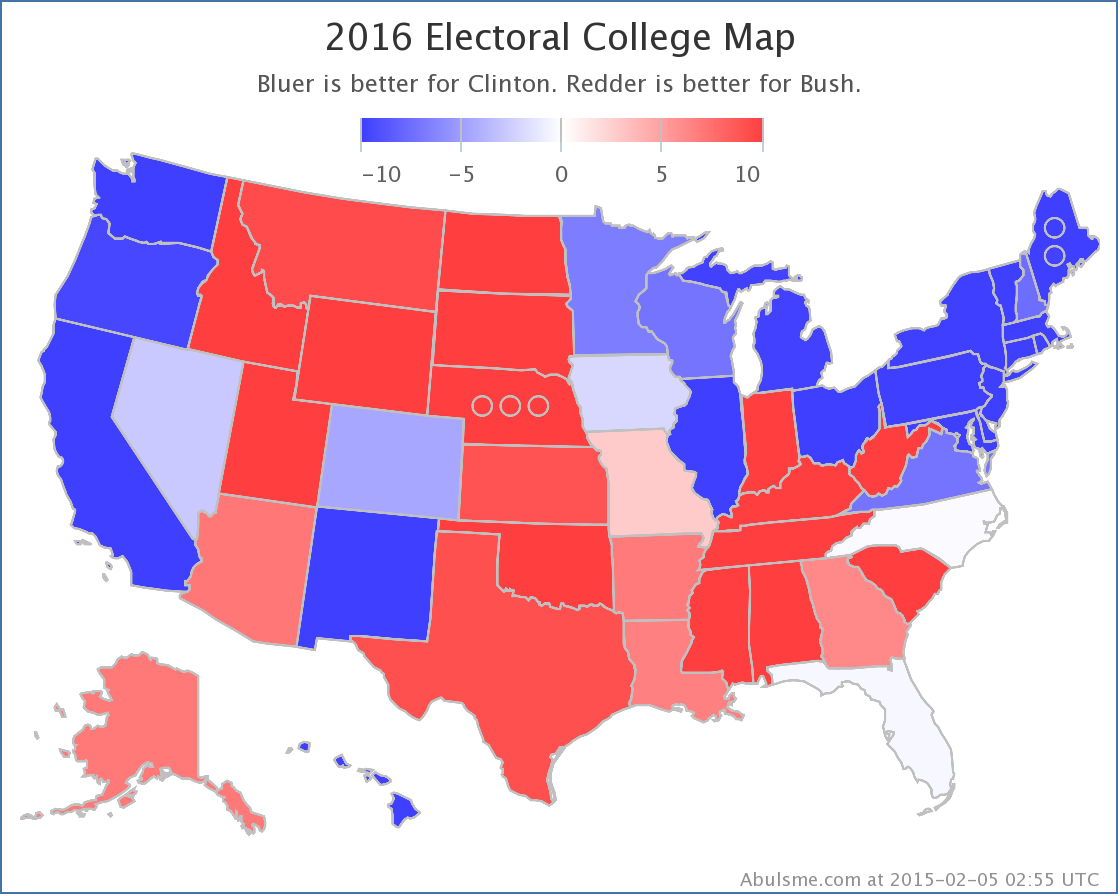
And finally, here is how that looks as a spectrum of the states broken down into the various classifications:

So there is our new “best polled” candidate combination… for the moment…
Today’s poll update was the addition of the Quinnipiac Swing State Poll, which included Florida, Ohio and Pennsylvania. Within the five “best polled” candidate combinations, this caused three changes worthy of note here. All three were moves toward Clinton and away from the Republicans.
First up, since it is the only one that actually involves changing the electoral summary for a candidate pair… Clinton vs Huckabee.

This is only the second time Clinton vs Huckabee in Ohio has been polled, but both new polls pull the state more toward the Democrat than the average of the last five presidential elections (which gave a 1.7% Dem advantage). This latest Ohio poll pulls the five poll average to a 5.7% lead for Clinton, which takes the state out of the “Weak” category which I allow to swing back and forth between the candidates to produce the “Best Case” scenarios for each candidate.
With the loss of Ohio from the list of “Possibles”, Huckabee’s “best case” moves from Clinton by 14 EV, to Clinton by 50 EV.
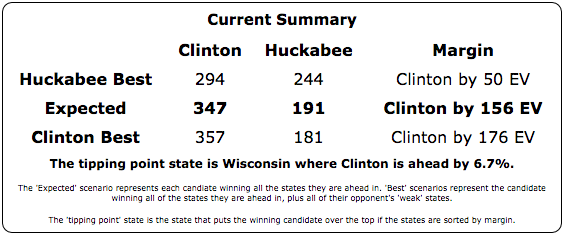
Of the five “best polled” candidate combinations, Clinton vs Huckabee is still #5 with much less comprehensive polling than Paul, Bush and Christie, so this may still be overstating where Huckabee would really be if more states were more fully polled.
The next two changes don’t actually change the Expected or Best cases for candidates, but rather are just changes to the “Tipping Point”. The tipping point essentially describes how much polls would have to move nationally (assuming an even distribution of movement in all states) to change who has the lead in the electoral college… in other words, how far ahead or behind the candidate is overall.
So next up is Clinton vs Paul:

With the new poll, Paul moves from being behind 8.8% in Ohio, to being behind 9.2% in Ohio. Both of these are in the “Strong Clinton” category, so there is no category change here, but Ohio was the tipping point state in this contest, and so any movement in this state will generally mean movement in the tipping point.

As you can see, the Clinton vs Paul tipping point has been between an 8% and 10% Clinton lead for most of the last year, so this isn’t breaking any new ground. The trend before last summer on this chart was basically just the process of getting enough polls to have a good view of this candidate pair, so things have essentially just been pretty flat since then. The new change doesn’t really change that, although I’m sure Paul would still rather see this line go in the other direction. (Well, if Paul was looking at my charts, which he isn’t. :-) )
Finally, Clinton vs Christie. This time, the changes in two states were relevant:
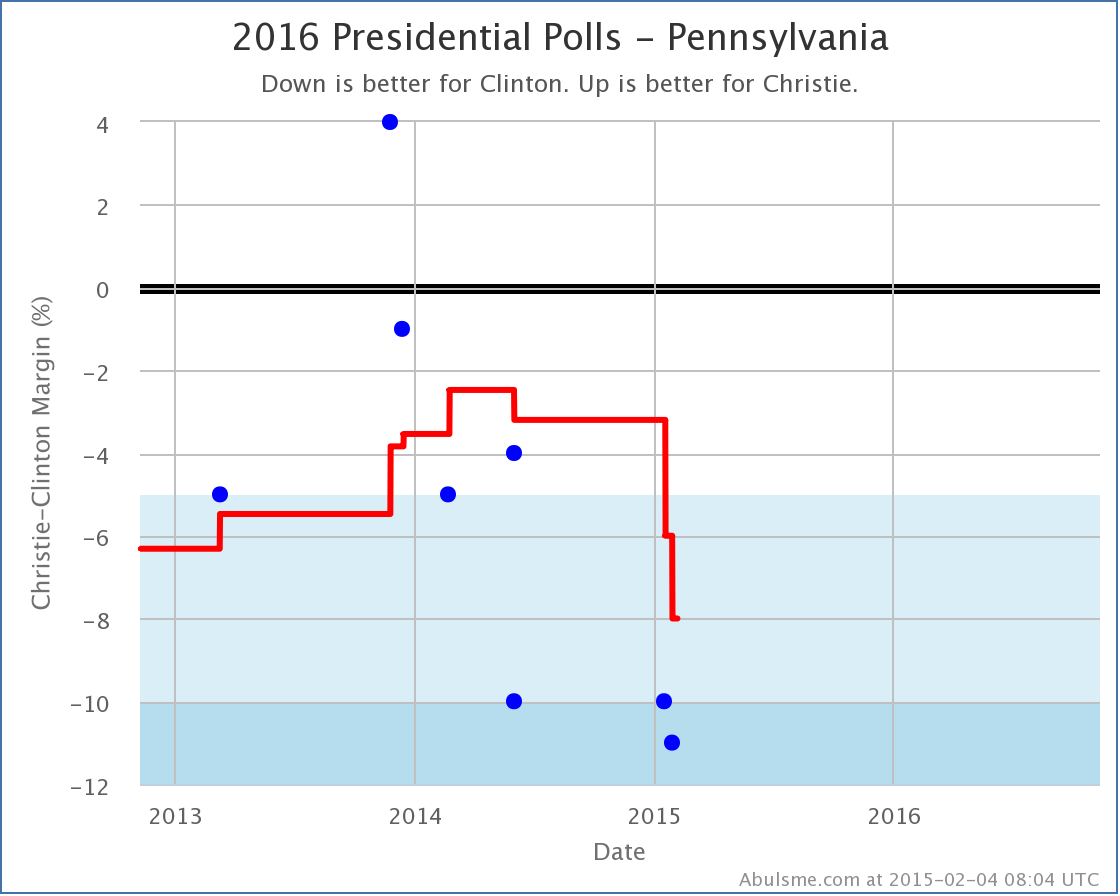
Last week I talked about Christie fading in Pennsylvania. The new polls today reinforce that trend, further worsening Christie’s position in Pennsylvania. It dropped him from being behind by 6.0% to being behind 8.0%, which pushed Pennsylvania past the previous tipping point of 7.5% in Minnesota.
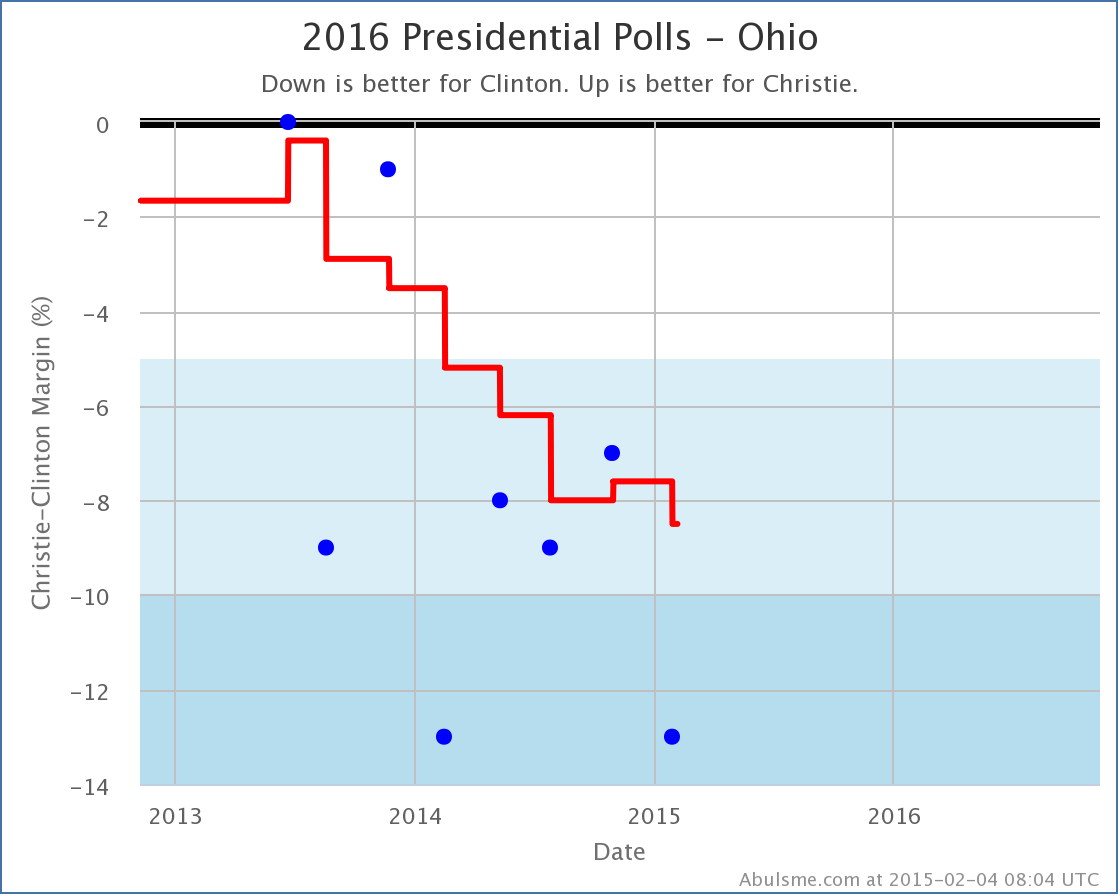
Now, Ohio also moved away from Christie with today’s polls (from Clinton by 7.6% to Clinton by 8.5%). If it hadn’t, Pennsylvania would have pushed past Ohio too, which would have had a different result for the Tipping Point.
In the end, the tipping point for Clinton vs Christie moved from Clinton by 7.5% in Minnesota, to Clinton by 8.0% in Pennsylvania.
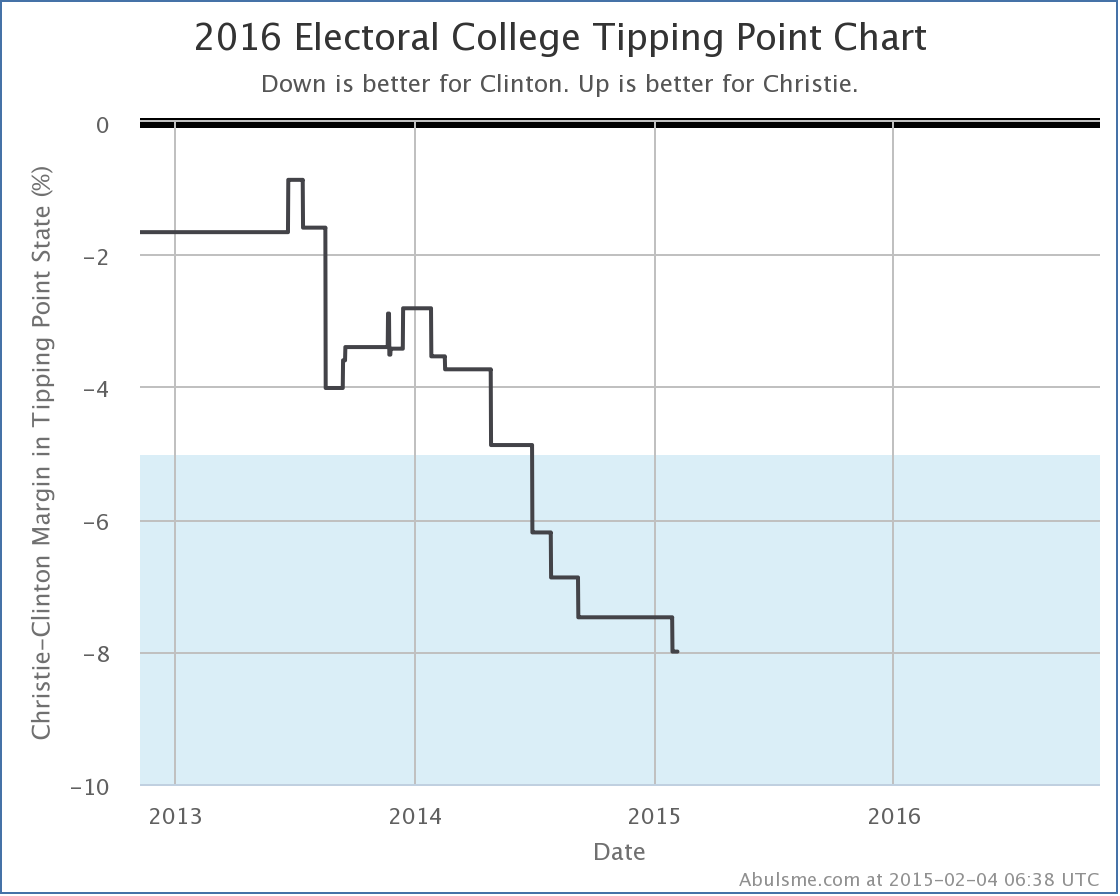
Unlike Clinton vs Paul, with Clinton vs Christie we’ve basically just been seeing a continued trend away from Christie and toward Clinton. Christie has not been faring well lately on this front.
Before closing up, lets look at a couple of the comparison charts between the five best polled candidate pairs.
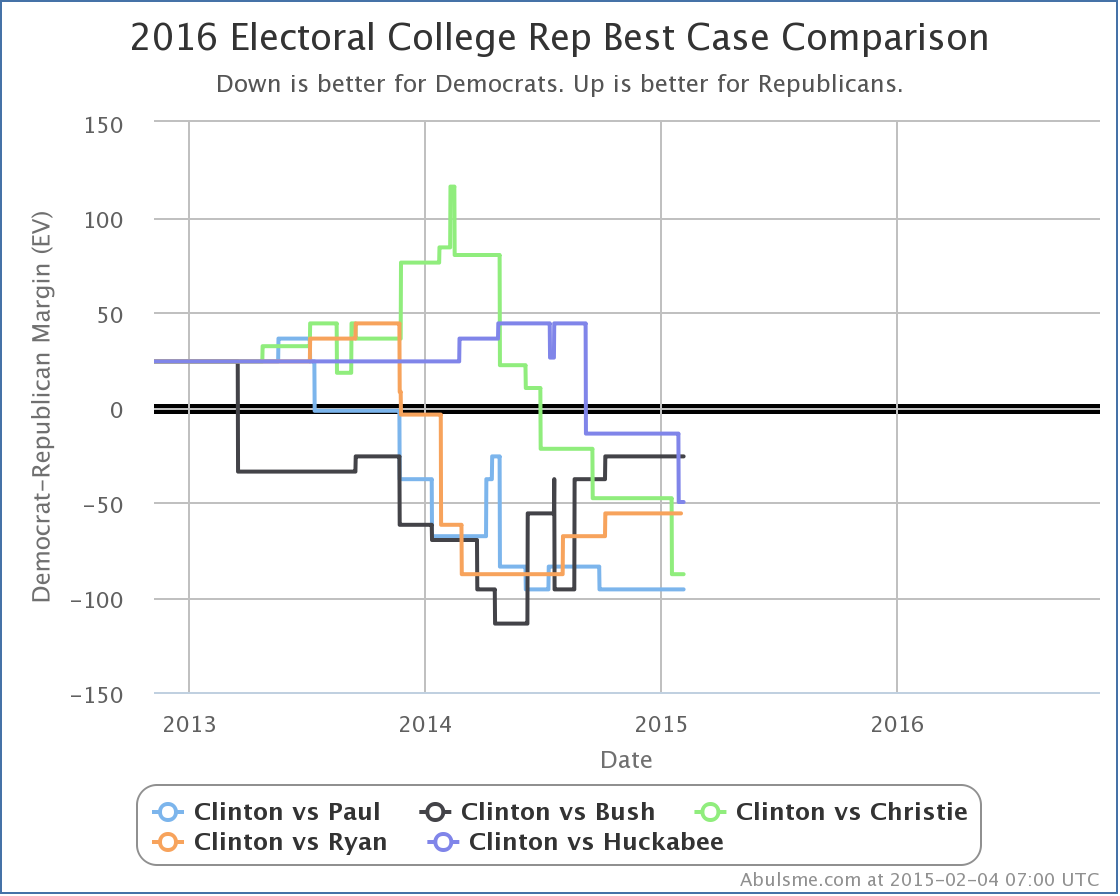
With Huckabee’s decline in best case, the Republican with the best best case against Clinton is now Bush, but that Best case is still losing by 26 electoral votes. (And the expected case if Bush did NOT manage to flip all the Weak Clinton states is Bush losing by 156 electoral votes.)
The worst best case versus Clinton is still Paul, losing by 96 electoral votes even if you give him all the Weak Clinton states. (Paul’s expected case is a bit better than Bush though, only losing by 138 electoral votes.)
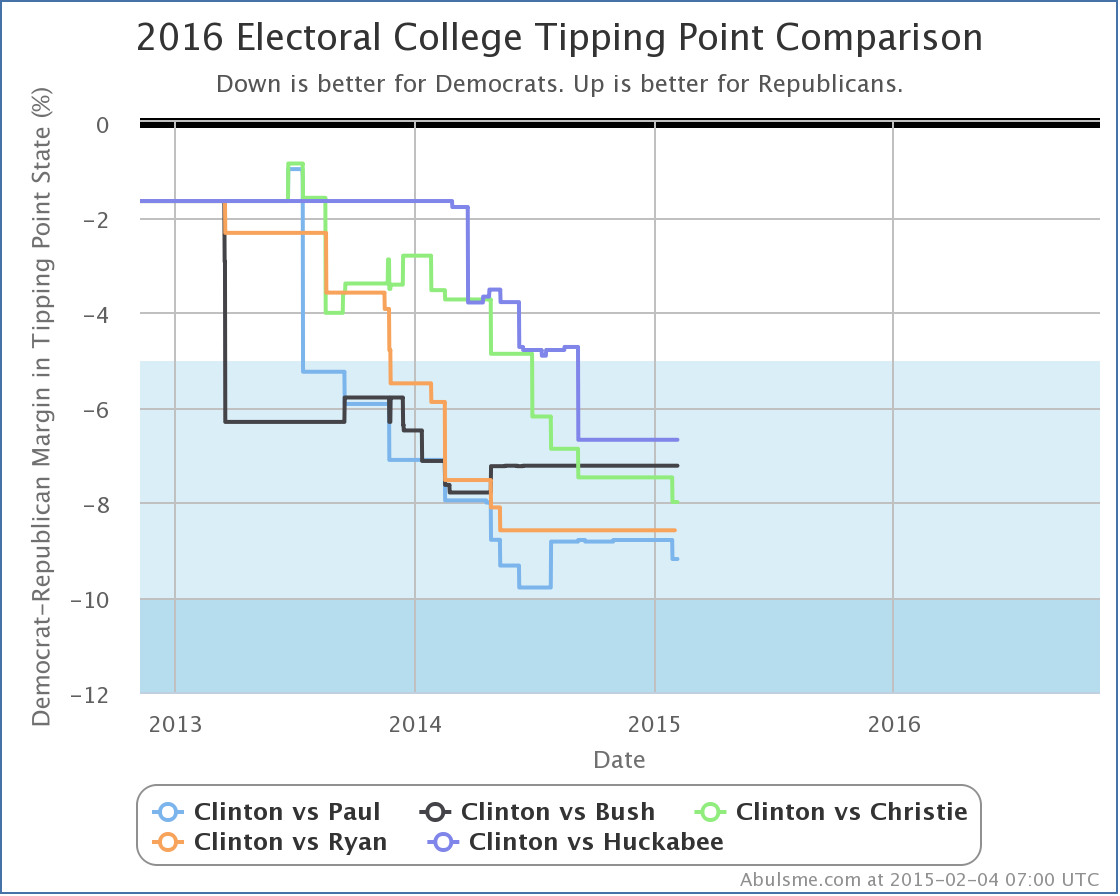
It looks a little different in terms of tipping point, with Huckabee doing best this time (behind by 6.7% in Wisconsin). Paul still in the rear here, behind by 9.2%.
Now, as people keep pointing out, and I will too, polls this far out from the election are NOT PREDICTIVE. All of the charts I’ve shown above say NOTHING about what the actual results in November 2016 will be. NOTHING.
However, that does NOT mean they are meaningless, or that they should be ignored. (Or why am I bothering with all this?) No, polls right now still give you a sense as to where things stand TODAY, which while it won’t tell you who will win 643 days from now, it DOES tell you how much work the candidates who are currently behind have to do in order to flip things. (Alternately, how much wiggle room the candidate in the lead has available as buffer against mistakes they might make.)
So, yes, pay attention to the polls. Even now. Just don’t make the mistake of believing that just because Clinton is way ahead of everybody now that necessarily means that will still be the case in a year and a half, when the polls DO start having some predictive power.
PS: There was also a tipping point change today for Clinton vs Romney but even with today’s new polls, Clinton vs Romney is still only the 20th best polled candidate combination, and with Romney declaring he isn’t going to run after all, he’s no longer as likely to climb the ranks as I thought a few weeks ago. If I had to guess as to the next change in the “Top Five” it would be Clinton vs Rubio (currently #7, but Rubio actively talking about being a candidate) replacing Clinton vs Ryan (currently #4, but Ryan having said he won’t run).
Edit 10:11 UTC – Added “Electoral College” prefix to title for consistency.
Polling in the last couple months has been a bit slow. Prior to the 2014 elections, there had been a lot of polling piggy backing on Senate polls. Not so much since the election. But finally, with the batch of polls I processed today, for the first time since I launched the Election 2016 site in November, there has been a change worth a blog post!*
Namely, looking at the Clinton vs Christie combination, with the addition of a PPP poll released on Thursday, Pennsylvania has slipped from “Weak Clinton” to “Strong Clinton”:

(Click through on the image for more details on the specific polls, etc.)
Now, you’ll notice there haven’t been all that many polls here. The five poll average at the moment covers 1.1 years. That is a long time. But even with this small number, you can see that in late 2013, Christie appears to have had a bit of a spike, making Pennsylvania look like a close state, with one poll even showing Christie ahead. But the more recent polls show Clinton with a healthy lead, and the 5 poll average now has Clinton with a 6.0% lead.
Now, this still leaves Christie looking better in Pennsylvania than the other 4 combinations that are “best polled” nationally:

(Again, click through on the image for more detail.)
Paul, Bush, Ryan and Huckabee all trail Clinton by more than 10% in Pennsylvania. So I guess Christie still has that.
Looking at what this means nationally, with Pennsylvania taken out of the “possible” category for Christie… at least for now… the summary for Clinton vs Christie looks like this:
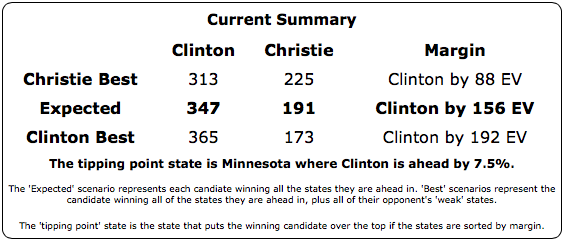
After Christie’s best case peaked at winning by 116 electoral votes back in February 2014, the trend has been downward, and the new change just continues that:

(Once again, click through on the image for… oh, never mind… you get how that works now, right?)
A lot of the “movement” here is still polling catching up with reality, but it does seem like Christie continues to fade, and so far he has not been able to reverse his fortunes. There is of course still a long time until we even get to the Iowa caucuses, let alone the 2016 election, but Christie isn’t doing all that great at the moment.
Since it is Christie’s “best case” that changed with the latest update, lets also take a quick look at the Republican best cases for all of the best polled combinations:

Wow, that looks messy. You’ll note that at the moment none of the five Republicans win against Clinton, even if you give them all of the close states. It looks like Huckabee actually has the best best case, but Huckabee is also the least well polled of the five, so take that one with a grain of salt. Otherwise, in terms of their best cases, in the last six to nine months while Christie’s situation has deteriorated vs Clinton, Bush and Ryan have improved theirs, and Paul has been basically flat.
Of course, Ryan has taken himself out of the race at this point. And Romney seems to have jumped in. As I described last week, as new polls are released Clinton vs Ryan should drop off the “Top 5 Best Polled” list and Clinton vs Romney will probably rise onto it. But not yet. Clinton vs Ryan is still #4 at the moment. The two additional polls for Clinton vs Romney since last week (one in NJ and one in PA) have moved Clinton vs Romney from the 21st best polled combination all the way up to… the 20th best polled combination. Still quite a ways to go. And still very sparse data. But if Romney is serious, the polls will come soon enough.
Stay tuned…
* For the moment, I consider a change to be “worth posting” if it involves one of the five best polled candidate pairs and it either changes one of the “summary” stats (the expected margin, the Republican best case margin, the Democratic best case margin), or there is a change to the tipping point margin of at least 0.1%. Of course, ALL changes in the summary, the tipping point margins, state categorizations, and even individual polls, for all candidate combinations, are posted at @ElecCollPolls for those interested in all those details.
There has been polling going on about the 2016 election since the 2012 election. (Actually, earlier, the first state level 2016 matchup poll in my database is from May 2012.) For most of that timeframe, the pollsters have been polling people who they deemed likely to run. Candidates were not for the most part outright declaring their intentions one way or another, and even when they seemed to, sometimes they were not believed.
That is now changing rapidly. While “formal” announcements that candidates are running 100% for sure for realsies may yet be a little further out, we now have candidates being pretty explicit that they are “exploring the possibility” or “considering” or whatnot, and we have a few that are being more and more definitive that they will not be running. Now, many of the people who are looking like they are running may decide not to after all before we get to the Iowa caucuses. And some of the ones saying they won’t run may change their minds. But we are starting to get a much better sense of who is in and who is out.
So, for instance, in the last couple weeks, we’ve had Romney making strong moves indicating he is in, while Ryan has stated that he has decided not to run. So why does the top of my 2016 Electoral College Analysis look like this?

Clinton vs Ryan is listed right there, but Clinton vs Romney is not. Why is this? Ryan is not running, shouldn’t he be dropped? Romney looks like he is running, and a number of polls on the Republican nomination show him in the lead at the moment, shouldn’t he be here?
The short answer is that I show the five “best polled” candidate combinations at the top of the page, and there is a lot of polling on Clinton vs Ryan (52 state level polls in my database) while there have been very few so far on Clinton vs Romney (only 4 state level polls in my database).
As pollsters start deciding to poll Clinton vs Romney more, and Clinton vs Ryan less (or not at all), this list of the five best polled combinations will update automatically and Clinton vs Ryan will drop off and Clinton vs Romney will very likely move onto this list. I choose not to hand edit this list by who seems to up or down in the primary polls at the moment, instead, I’ll let the fact that pollsters will show more interest in candidates that seem more likely to win take care of that. But it will take a little time for that to catch up, since actual polls have to be done first.
Of course, I also provide the drop downs, so anybody who wants to see any combination at all can go look. But the top five really are the ones that have decent polling, and beyond that there really isn’t a lot to see.
(Note: Once we actually get to the primaries and caucuses and have actual delegate counts, I will probably keep the five “best polled” list, but instead of defaulting to the best polled combination in terms of what I show on the rest of the page, I’d default to the delegate leaders in both parties… probably. Of course, there is a good chance these will match.)
Now, even for most of you who have already read the above, this is probably enough information. You can consider yourselves done now…
OK… for those few of you (if any) that want more detail and are still here…
I am trying to show the “best polled” combinations, which isn’t necessarily the same as the “most polled”. There are a number of ways one could calculate this, and none are perfect. I chose one way in particular, and it isn’t perfect either, and it certainly has its flaws, but it does the job well enough for these purposes.
Namely, my whole site is based on looking at a “5 poll average” for each candidate pair in each state. In certain cases this can actually include more than 5 polls to break various sorts of ties I care about. But these polls cover a certain amount of time.
For instance, right now if you look at Clinton vs Paul in North Carolina you’ll see that the average currently include five polls, which span the last 5.0 months. (The oldest poll in the average is from August 16th, just about 5 months ago as I’m making this post.)
As a contrast, if you look at Cuomo vs Perry in Vermont you’ll see that it has NEVER been polled, which means I pull in the last five general elections in Vermont as an approximation. That means the oldest data included in the average here is from November 6th 1996, so the average goes back 18.2 years.
States where this timespan is low are better polled than those where it is high. By the time we get to the election in 2016, I expect to see many close states with timespans measured in days.
But, if 2008 and 2012 are guides, some of the less contentious states may not get polled at all, or maybe just have one poll in the whole cycle. After all, everyone knows the Democrat is going to win DC by a huge margin, and the Republican is going to win Nebraska’s 3rd congressional district by a huge margin, and there aren’t that many electoral votes there either, so why bother?
Given that polling is concentrated in close states (and to some degree in big states even if they aren’t particularly close) and close states matter a lot more if you are trying to determine the electoral college outcome, I didn’t want to just average the timeframes of the 50 states (plus DC and 5 congressional districts).
So I decided to do a weighted average of the timeframes, weighted by the inverse of the absolute value of the margin. Since my method doesn’t allow exact ties in the averages, I don’t have to worry about division by zero, although really close states will have a very strong influence on the average.
So, for example, a really close state with a margin of 0.1% would get a weight of 1000, while something like DC (average margin of 80.3% over the last five presidential elections) would only get a weight of about 1.2. Using these weights, I construct an average of the 56 jurisdictions with electoral votes.
There is also the possibility of further weighting this by electoral college strength, I didn’t do that though. Isn’t this already complicated enough to explain?
In any case, from this you get a number from which you can compare how well various candidate pairs have been polled so far. Lets look at this for the top 25 candidate pairs:
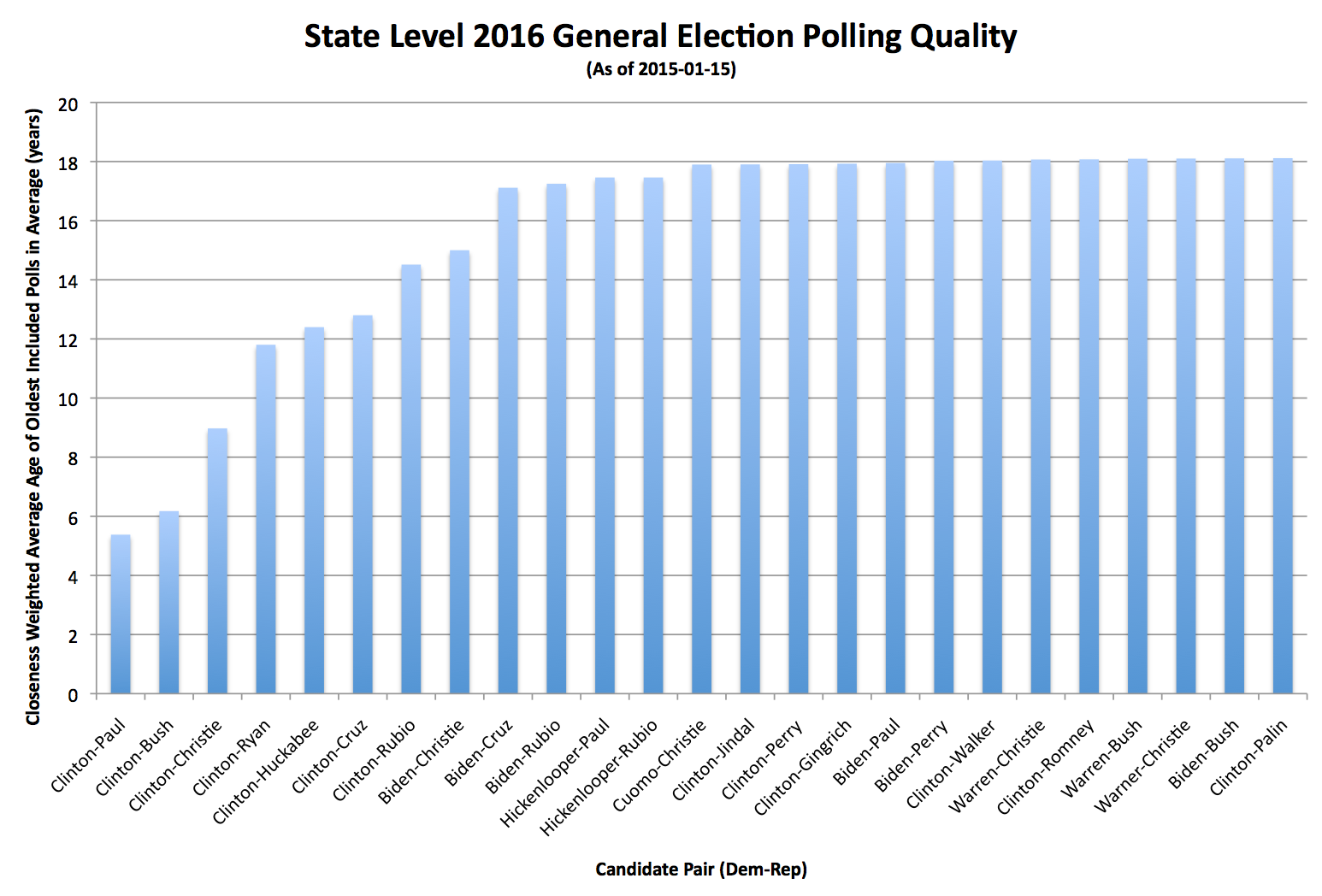 Click through on the image for a bigger version if desired. Click through on the image for a bigger version if desired.
The lower this number is, the better polled the combination has been. Candidate combinations that have not been polled at all will show up at 18.2 years at the moment.
You can see that Clinton vs Paul is best polled (5.4 years), with Clinton vs Bush right behind (6.2 years). Then we have a gap until Clinton vs Christie (9.0 years). Then another gap before Clinton vs Ryan (11.8 years), Huckabee (12.4 years) and Cruz (12.8 years). At this point we’re past the top five and you can tell we’re relying quite a lot on old elections and less and less on actual polling of these candidates.
The first non-Clinton combination comes in at #8: Biden vs Christie (15.0 years).
Where is Clinton vs Romney in this? #21. 18.1 years. Just BARELY better than no polling at all.
Hickenlooper vs Rubio has better polling by this metric than Clinton vs Romney. (#11, 17.5 years).
Looking at specific polls, there is only ONE poll for Hickenlooper vs Rubio, but it is in Colorado where the margin is 0.7%. Clinton vs Romney has been polled once each in New Jersey (margin 14.6%), New Hampshire (margin 3.3%), Iowa (margin 2.8%) and Florida (margin 1.1%). While some of those are close, they are less close, so lower weight is given to those.
There are NO states where Clinton vs Romney has a full five poll average (that would of course be impossible with only four polls).
By contrast, Clinton vs Paul has full five poll averages not including any old general election results in New Jersey (Clinton+22.4%), Pennsylvania (Clinton+12.6%), Florida (Clinton+11.3%), Virginia (Clinton+10.6%), Ohio (Clinton+8.8%), Michigan (Clinton+8.6%), New Hampshire (Clinton+6.1%), Iowa (Clinton+5.7%), North Carolina (Clinton+0.2%), Colorado (Paul+2.0%), Kentucky (Paul+4.2%), Kansas (Paul+6.8%) and Alaska (Paul+7.4%).
Bottom line, we can’t say much about a Clinton vs Romney matchup on a state by state level yet, there just hasn’t been enough polling yet. That will probably change rapidly over the next few months if Romney goes all in. And Ryan will fall off. And the “top five” list will otherwise adjust appropriately to changes in the field.
If you do look at Clinton vs Romney you will of course see something. The little polling there is has improved Romney’s “best case” from winning by 24 electoral votes to winning by 44 electoral votes. In this, he does better than any of the Republicans currently in the Top 5 best polled… but it is based on so little data, it is too early to make anything of it at all. You are still basically looking at the last five presidential elections, not any real Clinton vs Romney trend.
This is why I show only the Top 5 as highlighted combinations. Polling quality drops off very quickly, once you get much beyond that, you’re not looking at real data yet. This is also why while all changes will show up in the @ElecCollPolls twitter feed, I’ll only be posting analysis here when something significant changes in the status of one of the top five candidate combinations.
Well, not counting this post. :-) But I wanted to explain why Ryan is showing up, while Romney is not, and why even if we start getting some status changes in states for Clinton vs Romney, I most likely won’t start talking about them much until that combination has enough polls to show up on the top five best polled. Until then, we don’t really have a decent picture of what is going on in this sort of state poll based analysis.
Edit 22:15 to add more links and to change the “Clinton vs Romney has lower quality polling than” example from Hickenlooper vs Paul to Hickenlooper vs Rubio, so I would have an example that didn’t include any candidate showing up in the top five pairings.
Edit 2015-01-17 22:30 to correct Clinton vs Paul results in Colorado. It is Paul+2.0%, not Clinton+2.0% as previously stated.
I was asked by a reader for my thoughts on a blog post that was recently republished on the Houston Chronicle website. Read the whole thing and come back, but the key conclusion is here:
Reality-check on the 2014 results (Chris Ladd, GOPLifer)
This means that the next Presidential election, and all subsequent ones until a future party realignment, will be decided in the Democratic primary. Only by sweeping all nine of the states that remain in contention AND also flipping one very solidly Democratic state can a Republican candidate win the White House.
I responded to the reader by email, but I decided to post a slightly cleaned up version here.
Yes, at the moment every single one of the most commonly polled Republican candidates loses to Hillary even if you gift the Republican all of the states they are behind in by less than 5%. Yes, if you add up all the states where the Democrats have averaged a greater than 5% lead over the last five presidential elections, they are only a handful of electoral votes away from winning and only need to win one or two of the historically close states to win, where the Republicans have to almost sweep those states to win. See my “The Race Begins” post for more thoughts on this.
If this was Fall 2016 and things still looked like this, then yes, it would be pretty close to inevitable that the Democrats were cruising to an easy victory.
HOWEVER, it is only 2014, and once we get into full fledged campaign mode, Hillary has lots of weakness that can and will be exploited by the Republicans. A lot depends on who the Republicans nominate, but if they manage to nominate someone that is capable of sounding reasonable to the “median voter” like a Jeb Bush, or they nominate someone like Paul who would scramble things up a bit by having a mixture of positions that slice across issues in a very different way than other Republicans, then we will perhaps see some interesting dynamics.
If you look at my “Tipping Point” comparison, you see that the worst off of the five best polled Republican candidates (Paul) is currently behind by 8.8% in the tipping point state.

(Click through on the image for more detail.)
An 8.8% margin sounds like a pretty big lead for the Democrats, but actually, it means if the Republicans are able to flip 4.4% of voters through the campaign process (assuming uniform movement in all the close states) then they can win. 4.4% doesn’t seem quite as insurmountable, does it?
Now, things are pretty highly polarized right now, so changing the minds of almost 5% of voters may still be a tall order.
BUT, in the next two years a lot can happen:
- If you have Hillary being slimed to within an inch of her life by every smear you can probably think of…
- If you have the Republican nominate someone that doesn’t immediately just “ooze” crazy or slimeball… not to the left leaning folks who would think that of any Republican, but to those rare birds in the middle that really could go either way…
- If the Republicans nominate someone who really comes across as a likable person… and who doesn’t end up having to destroy their appeal to general election voters in order to win the nomination…
- If Hillary makes some silly mistakes that make her seem cold, distant or unlikable…
- If the economy ends its growth streak and goes back into recession…
- If there are more things going on with the Obama administration either in foreign policy or domestically that make the Democrats look incompetent…
- If the public just plain has a strong “give the other side a chance now” feeling, which is common after eight years, regardless of who has been there and what the current issues of the day are, or even who the specific candidates are.
If you get a confluence of a few of these things, it is pretty easy to see 5% of voters deciding to switch from their preference from Democrat to Republican, making a Republican win quite possible.
(And if it isn’t Hillary for whatever reason, of course everything changes, but despite her potential negatives, Hillary is probably stronger here than any of the other “if it isn’t Hillary” people who are occasionally mentioned.)
Don’t get me wrong, the Democrats have a clear advantage in 2016. (In the Senate too, although I haven’t done any analysis of that myself.) The Republicans are starting from a very real disadvantage. If I had to put odds on it, I’d give the Democrat maybe a 70% or 75% chance of winning in 2016. But Ladd made it sound almost completely inevitable in that article.
It isn’t inevitable. The Republicans have to get somewhat lucky. Or the Democrats have to screw up. But the Democrats have a tendency to screw up. So I wouldn’t count the Republicans out by any means. There are still lots of ways for them to make up the deficit and win, despite their disadvantages going in.
Bottom line, I agree with the article that the Democrats are heavily favored in 2016 and have a lot of structural advantages… but I think Ladd overstates it by quite a bit.
In the original email to my reader, I then went on to speculate about 2020 and beyond, specifically that assuming a Clinton victory in 2016, I feel there are high odds that she ends up as a one term president, despite current Republican structural disadvantages. But it is only 2014, so maybe I’ll just wait a little while for that prediction. :-)
Edit 18:36 UTC to add “If it was Fall 2016” comment.
Edit 19:19 UTC for minor spacing and wording fixes.
Edit 2015-01-10 07:28 UTC to add the “Electoral College:” prefix to the title
|
|














































